REPRODUCTION IN ORGANISMS for Class 12 BIOLOGY
INTRODUCTION
- Reproduction is defined as a biological process in which an organism gives rise to young ones (offspring) similar to itself. The offspring grow, mature and in turn produce new offspring. Thus, there is a cycle of birth, growth and death. Reproduction enables the continuity of the species, generation after generation.
The period from birth to the natural death of an organism represents its life span.

When offspring is produced by a single parent with or without the involvement of gamete formation, the reproduction is asexual. When two parents (opposite sex) participate in the reproductive process and also involve fusion of male and female gametes, it is called sexual reproduction.
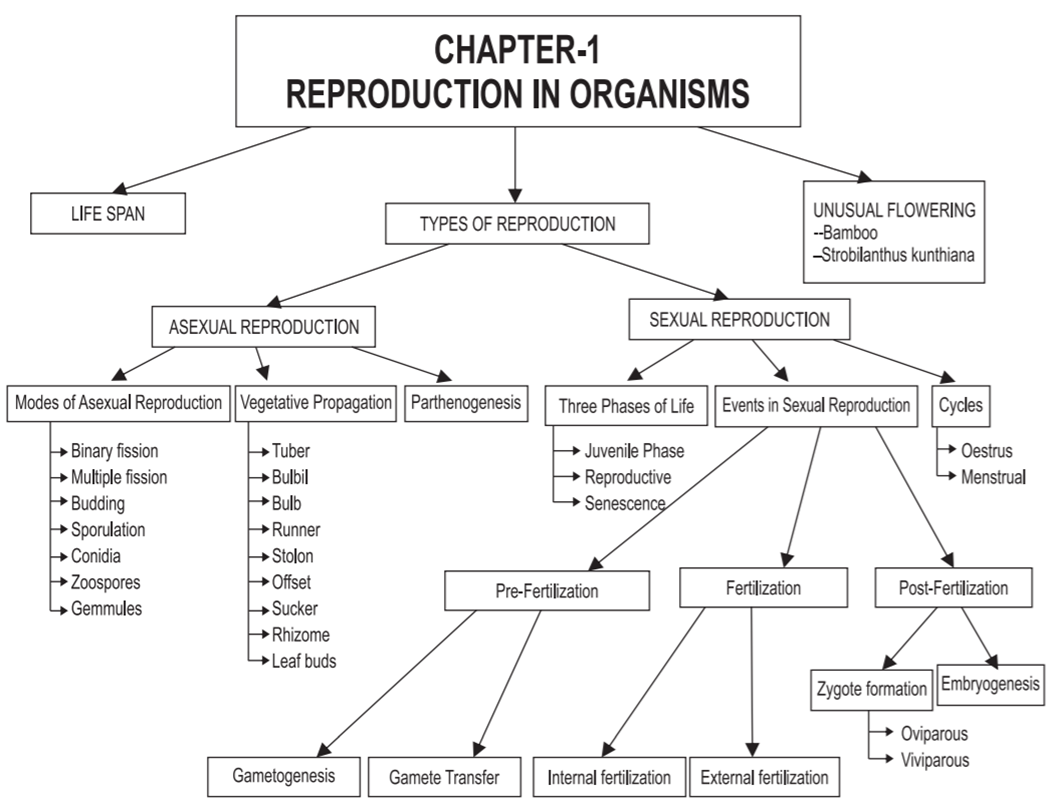
INTRODUCTION
- Reproduction is defined as a biological process in which an organism gives rise to young ones (offspring) similar to itself. The offspring grow, mature and in turn produce new offspring. Thus, there is a cycle of birth, growth and death. Reproduction enables the continuity of the species, generation after generation.
The period from birth to the natural death of an organism represents its life span.

When offspring is produced by a single parent with or without the involvement of gamete formation, the reproduction is asexual. When two parents (opposite sex) participate in the reproductive process and also involve fusion of male and female gametes, it is called sexual reproduction.

INTRODUCTION
- Reproduction is defined as a biological process in which an organism gives rise to young ones (offspring) similar to itself. The offspring grow, mature and in turn produce new offspring. Thus, there is a cycle of birth, growth and death. Reproduction enables the continuity of the species, generation after generation.
The period from birth to the natural death of an organism represents its life span.

When offspring is produced by a single parent with or without the involvement of gamete formation, the reproduction is asexual. When two parents (opposite sex) participate in the reproductive process and also involve fusion of male and female gametes, it is called sexual reproduction.

INTRODUCTION
- Each and every organism can live only for a certain period of time. The period from birth to the natural death of an organism represents its life span. Life spans of a few organisms are given in Figure 1.1. The life span varies from organisms to organisms. In Figure 1.1 we can see that life span of a May Fly is one day while life span of the Great Banyan tree located in Howrah (Kolkata) in Acharya Jagadish Chandra Bose Indian Botanic Garden is the biggest and oldest tree in India having life span of 250 Years. It covers an area of about 14500 square meters or 3.5 acres making it the widest tree in the world. Between these two extremes are the life spans of most other living organisms. You may note that life spans of organisms are not necessarily correlated with their sizes; the sizes of crows and parrots are not very different yet their life spans show a wide difference. Similarly, a mango tree has a much shorter life span as compared to a peepal tree. Whatever be the life span, death of every individual organism is a certainty, i.e., no individual is immortal, except

- Single-celled organisms because they reproduce before their death. Given this reality, have you ever wondered how vast number of plant and animal species have existed on earth for several thousands of years? There must be some processes in living organisms that ensure this continuity. This process is called Reproduction. Reproduction is the fundamental characteristic of Life, without reproduction life is not posiible on planet earth. The Theory of reproduction was given by The great French microbiologist Louis Pasteur when he proposed Omnis vivum e vivo or Life begets life.

- Reproduction is a fundamental feature of living organisms which involves the transmission of genetic material from one generation to the next ensuring the survival of species over long periods of time. Reproduction is defined as a biological process in which an organism gives rise to young ones (offspring) similar to itself. The offspring grow, mature and in turn produce new offspring. Thus, there is a cycle of birth, growth and death. Reproduction enables the continuity of the species, generation after generation.
- Phases of Life:
Life span of an organism usually includes four phases:- Juvenile phase
- Reproductive phase OR Maturity phase
- Ageing and Senescence
- Death
Life span of animals
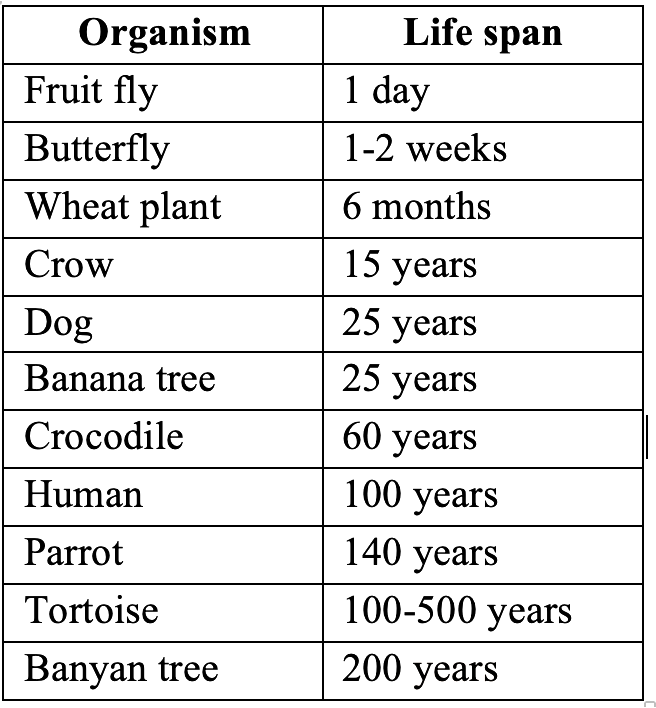
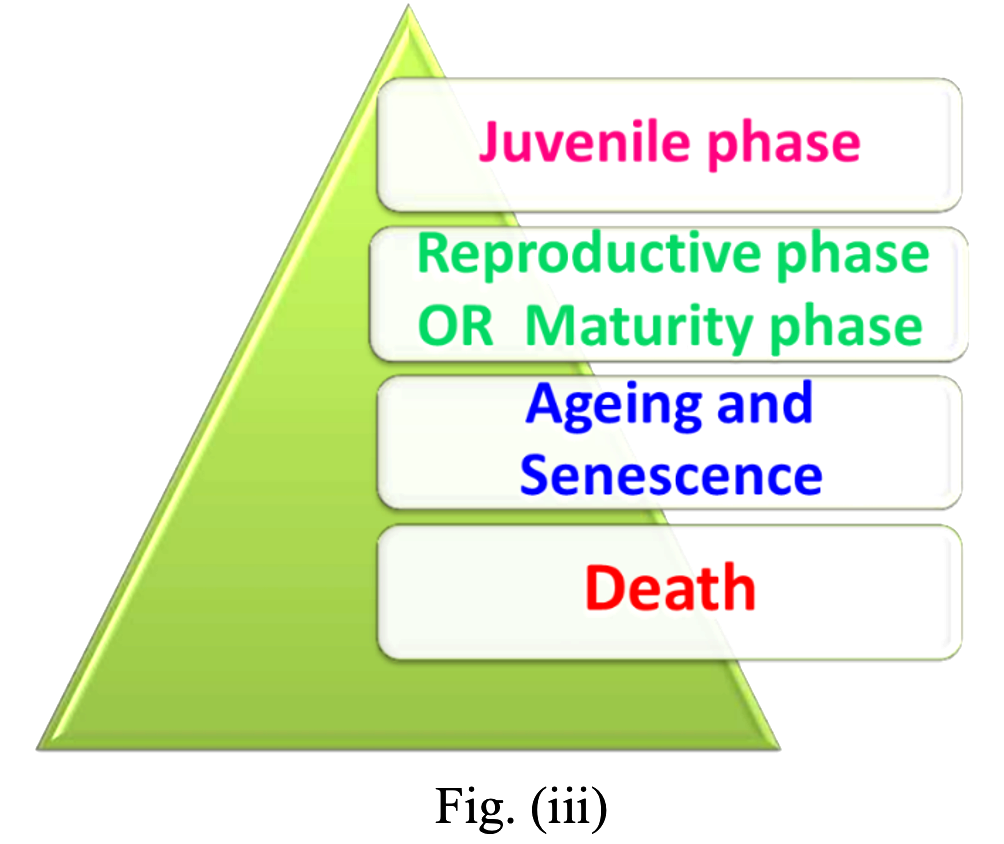
INTRODUCTION
- Reproduction is defined as a biological process in which an organism gives rise to young ones (offspring) similar to itself. The offspring grow, mature and in turn produce new offspring. Thus, there is a cycle of birth, growth and death. Reproduction enables the continuity of the species, generation after generation.
The period from birth to the natural death of an organism represents its life span.

When offspring is produced by a single parent with or without the involvement of gamete formation, the reproduction is asexual. When two parents (opposite sex) participate in the reproductive process and also involve fusion of male and female gametes, it is called sexual reproduction.

CHAPTER WEIGHTAGE
- Yeah basically introductory chapter hai toh issey jyda complex and jyada marks ke questions nhi aate but generally ek ya do short ya very short ya koi MCQ ya kisi match the following type questions iss chapter se questions puch liya jata hai jasie ki difference between pre and post fertilisation events or what is vegetative reproduction vgarah vgrah basic questions.
CHAPTER WEIGHTAGE
- Yeah basically introductory chapter hai toh issey jyda complex and jyada marks ke questions nhi aate but generally ek MCQ ya kisi match the following type questions iss chapter se questions puch liya jata hai.
CHAPTER WEIGHTAGE
- Yeah basically introductory chapter hai toh issey jyda complex and jyada marks ke questions nhi aate but generally ek MCQ ya kisi match the following type questions iss chapter se questions puch liya jata hai.
ASEXUAL REPRODUCTION
- Animals reproduce by two fundamental methods:
- In asexual reproduction a single parent is involved. In this method, a single-celled or many-celled parent individual either splits, or buds or fragments into two identical daughter cells or individuals. In asexual reproduction Gametes are not formed therefore it is also called Agametogny or Agametogenesis. For example, many acellular protists, such as Amoeba, Paramoecium, Euglena, and multicellular metazoans, such as Sycon, Hydra, Tubularia, Planaria, Ascidia, reproduce primarily by asexual means. t involves only mitotic cell divisions and is also termed Somatogenic reproduction.
- Types of Asexual Reproduction:
- Binary fission :
- The parent organism divides into two halves and each half forming an independent daughter organism.
- A group of genetically identical offsprings produced from single parent is called clone. Organisms that undergo binary fission are immortal. On the basis of plane of division Binary fission is of different types;
Types of binary fission : - Longitudinal binary fission - Euglena and Vorticella
- Transverse binary fission - Paramoecium and Planaria
- Oblique binary fission – Ceratium
- Binary fission :
Asexual and Sexual:
- The parent body divides into many daughter organisms. It is generally used in parasites or in adverse conditions.
- e.g., Amoeba, Plasmodium, Monocystis
- In budding a parent like miniature organism develop from the parent body.
- It is of two types
- Exogenous budding – It takes place in Hydra
- Endogenous budding (Gemmulation) - takes place by gemmule formation in sponges
- In fragmentation a part of the body breaks and give rise to entire organisms. e.g. Starfish, Flatworms, Sponges, Coelenterates.
- Division of multinucleate parent into many multinucleate individuals without nuclear division. Later on nuclear division occurs to maintain chromosome number e.g. Opalina, Pelomyxa.
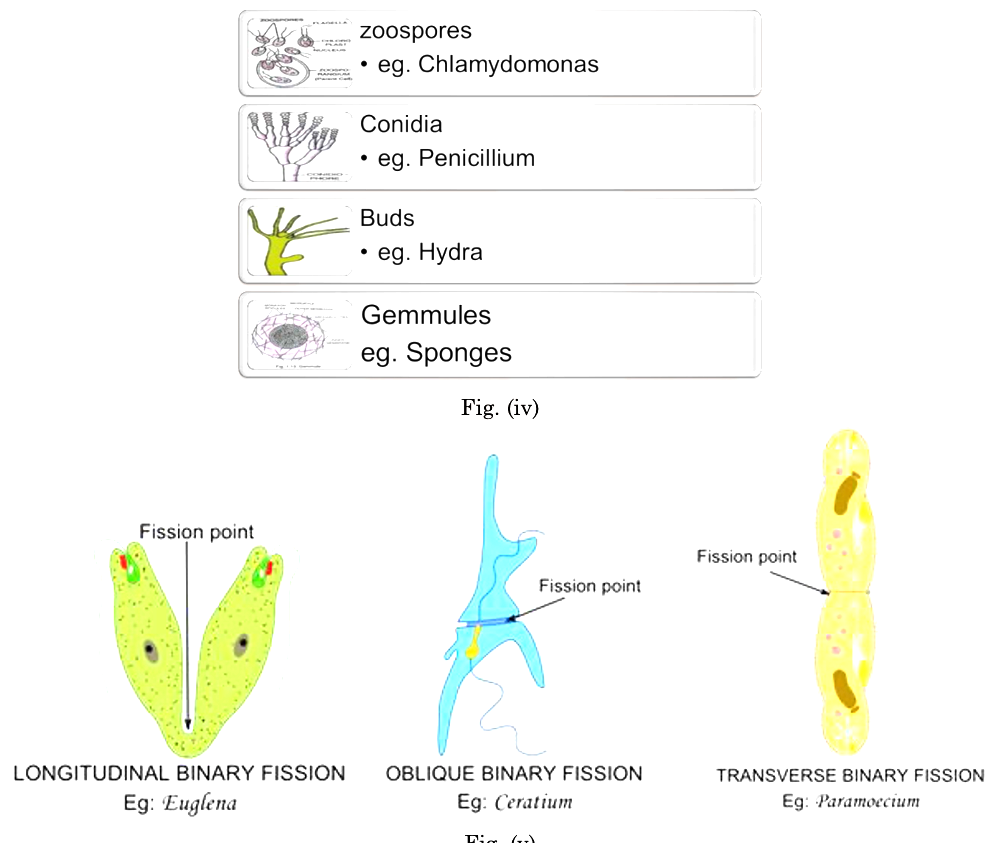
Multiple Fission

Plasmotomy
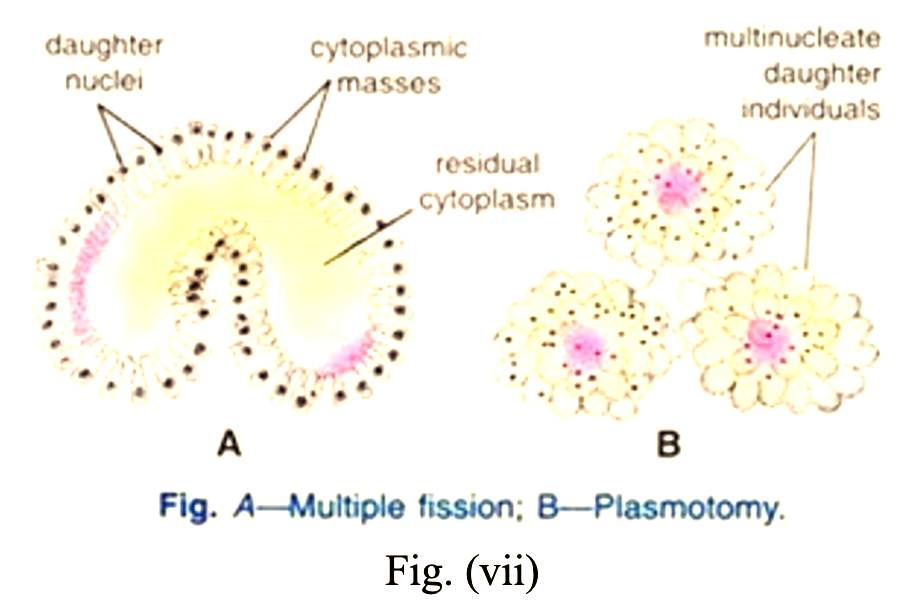
Budding

Fragmentation

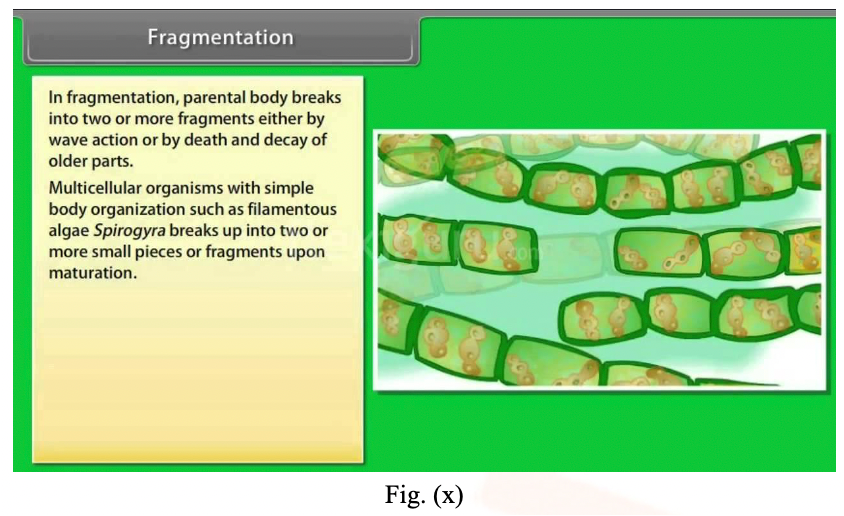
ASEXUAL REPRODUCTION
- A single parent in involved thus the offsprings are identical copies of their parent cells thus they are sometimes known as clones (morphologically and genetically similar individuals).
- Asexual reproduction is common among single-celled organisms, and in plants and animals with relatively simple organisations.
- In Protists and Monerans, during reproduction the single cell splits/divides into new daughter cells (offsprings) that is in these organisms cell division is itself a mode of reproduction.
- Principle forms of asexual reproduction are :
1. Binary fission
2. Multiple fission
3. Gemmulation
4. Budding
5. Fragmentation - This is the simplest and most common method of asexual reproduction particularly seen in unicellular organisms occurring under favourable conditions of the environment such as availability of nutrients and other growth factors.
- Simple Binary Fission : Irregular-shaped organisms such as Amoeba and the plane of division is difficult to ascertain.
- Transverse Binary Fission: in this case the plane of division is at right angle to the long axis of the animal. Ex : Paramecium & Planaria .
- Longitudinal Binary Fission : plane of fission is parallel to the long axis. Ex : Euglena, Vorticella and in some corals.
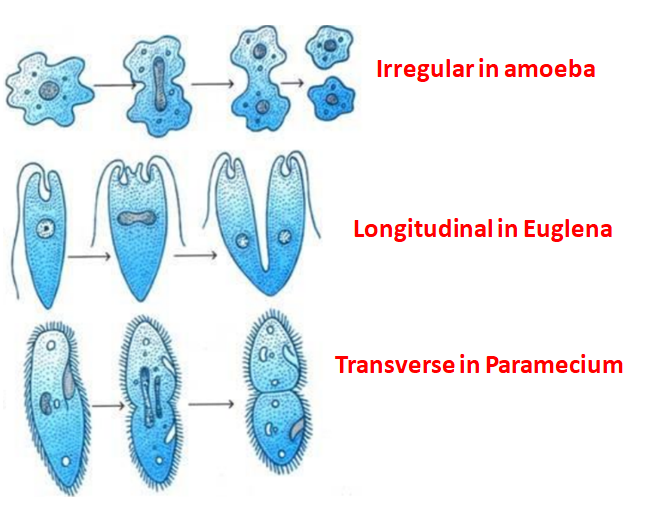
- The parent nucleus undergoes repeated divisions to form a large number of daughter nuclei followed by the division of the cytoplasm.E.g., Amoeba, Plasmodium (malaria parasite) etc.
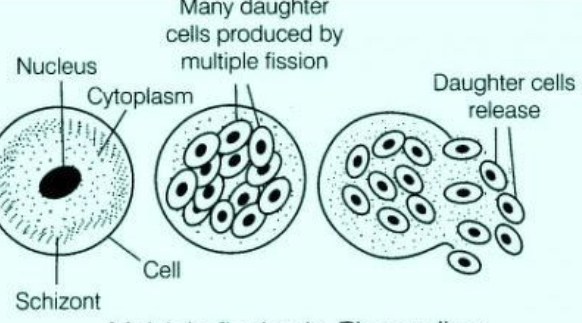
- In this case buds are formed within the parent body and are called gemmules. These are also called endogenous buds or internal buds. Ex : Sponges
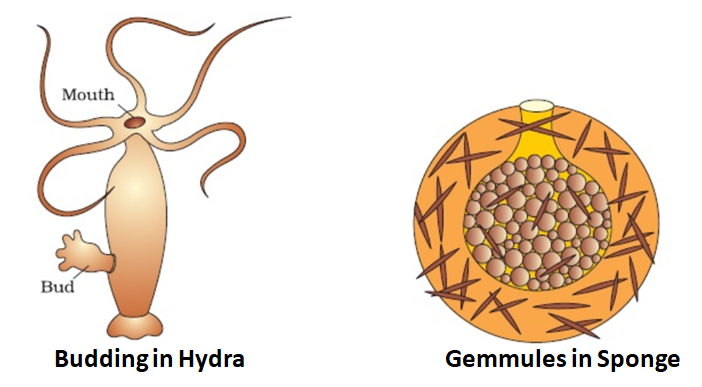
- During the process of bud formation or budding an outgrowth or bud appears on the parent body. The bud may be unicellular or multicellular.
- The bud develops to its full size either after detachment from the parent or prior to detachment being attached to its parent body. Budding may be external as in Hydra, Yeast or internal as in Acinata.
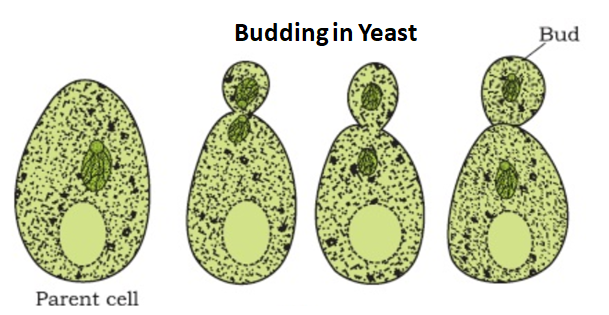
- In this mode of reproduction the parent cell is divided into many fragments and each fragment develops into a new organism. Ex :Spirogyra, Planaria
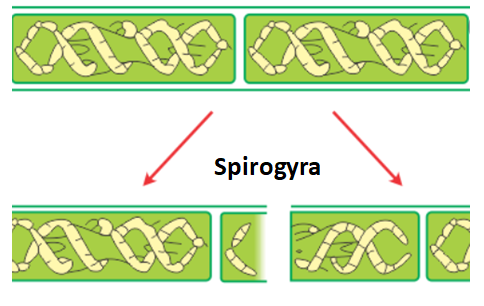
 Other Common Asexual Structures
Other Common Asexual Structures - Members of the Kingdom Fungi and simple plants such as algae reproduce through special asexual reproductive structures of which the most common structures are zoospores that usually are microscopic motile structures. Other common asexual reproductive structures are conidia (Penicillium), buds (Hydra) and gemmules (sponge).

- This method of asexual reproduction involves the vegetative structures (non-sexual parts) of plants like stem, roots and leaves. So reproduction by these structures is known as vegetative reproduction.
- Types of vegetative reproduction :
Cutting: A part of a plant like stem or leaf, is cut off and planted. Ex : Rose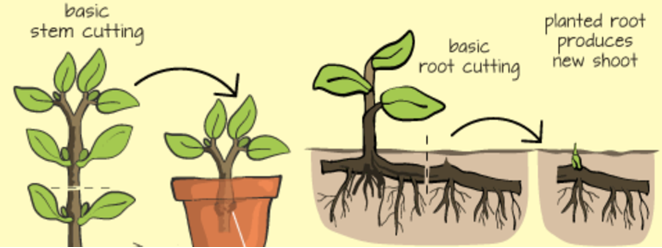
Grafting: In grafting, the part to be grafted (scion) is attached to the stem of another plant that remains rooted in the ground (stock).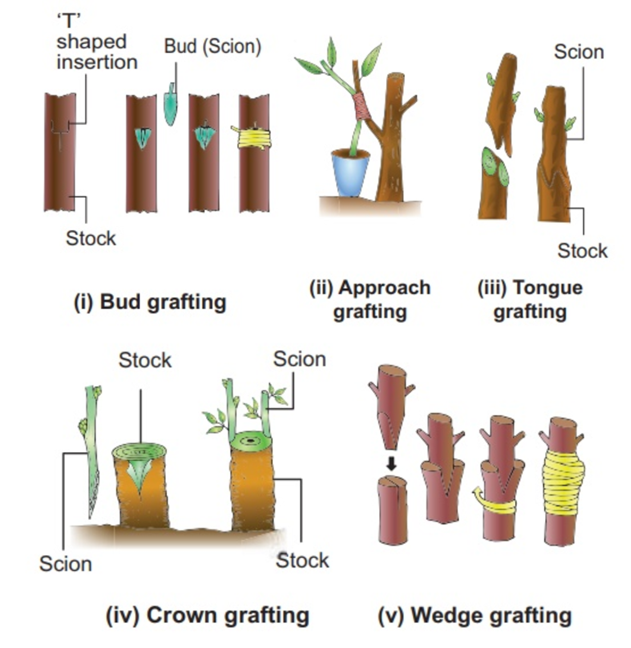
Layering : Branches of plant are bend so that they can touch the ground and the part touching the ground develops adventitious roots and a new plant starts at that site.
Binary Fission
Types of binary fission :
Multiple Fission
Gemmulation
Budding
Fragmentation
Vegetative Propagation
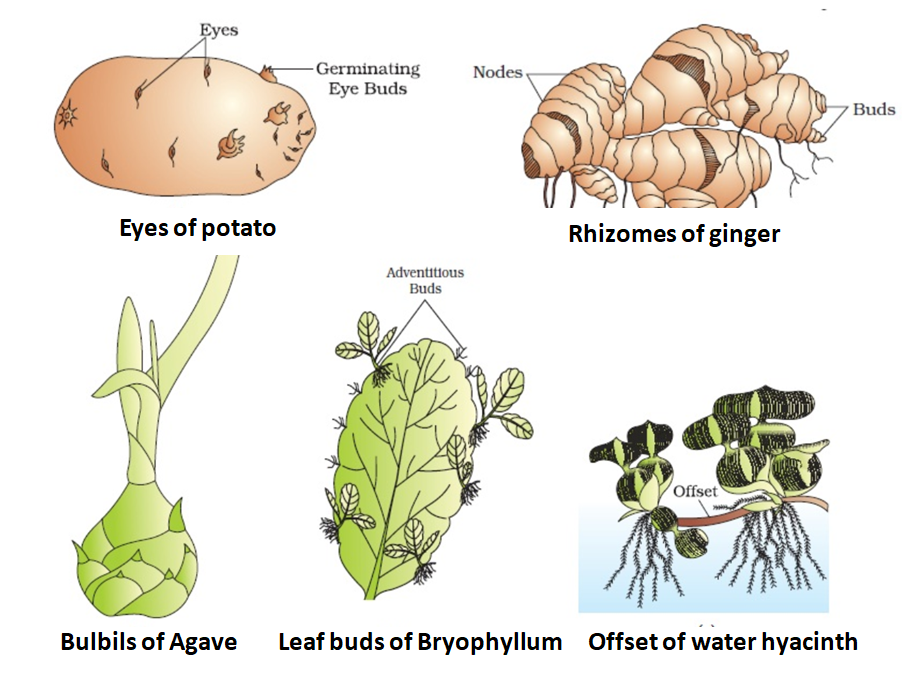
ASEXUAL REPRODUCTIO KYA HOTA HAI ?
- Reproduction ka wo method jisme ek hi parent involved hota hai and there is no formation of fusion of gamete, that mode is known as asexual mode of reproduction.
- Iss case me jo bache paida hote hain wo bilkul apne parent ki exact copy hote hai bolo toh bilkul identical that is why we call such offsprings as clones. Clone ka matlab hota hai wo, jo apne parent se genetically and morphologically bilkul hi identical ho.
- Different organism me different modes hote hai asexual reproduction ke but asexual mode generally hume single celled and lower life forms me dekhne ko milta hai but there are few plants and few organisms from kingdom animalia jinme asexual reproduction dekhni ko milti hai.
- The most common type of asexual reproduction is fission. Isme parent cell simply 2 ya 2 se jyada cells me split/divide kar jata hai. Yeah aisa case hai unicellulars me jha ek cell fully mature hokr jaise hi reproduction ke liye tyaar hota hai toh wo ek cell, baki daughter cells me split ho jata hai yani ki basically hume dekhne me lag ra hai ki cell keval divide kr rha hai but actual me in organisms me cell division and reproduction synonyms hai. Ex : Amoeba, Paramecium etc. toh such organisms are considered immortals.
- Fission is further of many types. Agar division aisey hi bina kisi division plane ke hogya toh it is known as simple fission and generally isme 2 daughter cells milte hai toh hum isko binary fission kehte hain. Binary ka matlab hai 2 and fission ka matlab hai split/divide karna so naam me hi definition hai ki binary fission wo fission hota hai jisme ek parent cell 2 daughter cells me divide krta hai. Ex : Amoeba.
- Ek fission aisa hota hai jisme plane of division is parallel to the long axis of the cell. Such a division is called Longitudinal division. Ex: Euglena
- Ek or tareeke se fission hota hai jisme plane of division is perpendicular to the long axis of the organisms toh jo yeah perpendicular plane hai issi ke liye hum “transverse” term use krte hai and hence the name of this type of division is transverse division which is seen in organisms like Paramecium
- Jo ab tak uper fission discuss kiye wo sab favourable conditions me hote hai yani ki jab cells ke pass apmple amount me nutrition hai, optimum temperature and moisture conditions hai toh cells aise divide krte hai. But kabhi kabhi environment me harsh conditions aa jati hai like nutrition vgrah properly nahi mila toh aisey me kuch unicellular organisms jaise ki Amoeba form a spherical structure known as cyst jisme kafi protective layers hoti hai and this process is known as encystation. Yeah toh survival strategy hui. Iske baad jab bhi achi favourable conditions aayengi toh cyst divides by multiple fission and cyst wall layers will rupture to release many daughter amoebae.
- Next method to reproduce asexually is via budding. Budding me parent cell ki side me hlki si outgrowth hoti hai jisme nucleus and thoda sa cytoplasm hota hai. Dheere dheere parent cell iss chotu daughter cell (yani ki bud) me nutrients and baki growth factors supply karta hai toh bud slowly slowly grow krna shuru krta hai finally wo bud uss parent cell se detach hokar alag apna khud ka vajud bna leta hai. Yeah method hume Hydra me dekhne ko milta hai.
- Next we have fragmentation jisme ek parent cell kafi sari units me divide kr jata hai ya kafi sare chote fragments me tut jata hai, and har fragment se ek new individual bnta hai. Ex: Spirogyra
- Gemmulation me parent cell ke andr hi buds bante hai and har bud ek new organism banta hai. Ex : Sponges
- Another form of asexual reproduction is : vegetative Reproduction. Iss mode me plants generally apne vegetative parts jaise ki stem, roots and leaves se reproduction hoti hai. Yhaan bhi we have different methods of vegetative reproduction such as layering, cutting, grafting etc. now details of these methods are not in our syllabus but these processes have been mentioned in brief in the lower section.
- In plants, the units of vegetative propagation such as runner, rhizome, sucker, tuber, offset, bulb are all capable of giving rise to new offspring.
ASEXUAL REPRODUCTIO KYA HOTA HAI ?
- Reproduction ka wo method jisme ek hi parent involved hota hai and there is no formation of fusion of gamete, that mode is known as asexual mode of reproduction.
- Iss case me jo bache paida hote hain wo bilkul apne parent ki exact copy hote hai bolo toh bilkul identical that is why we call such offsprings as clones. Clone ka matlab hota hai wo, jo apne parent se genetically and morphologically bilkul hi identical ho.
- Different organism me different modes hote hai asexual reproduction ke but asexual mode generally hume single celled and lower life forms me dekhne ko milta hai but there are few plants and few organisms from kingdom animalia jinme asexual reproduction dekhni ko milti hai.
- The most common type of asexual reproduction is fission. Isme parent cell simply 2 ya 2 se jyada cells me split/divide kar jata hai. Yeah aisa case hai unicellulars me jha ek cell fully mature hokr jaise hi reproduction ke liye tyaar hota hai toh wo ek cell, baki daughter cells me split ho jata hai yani ki basically hume dekhne me lag ra hai ki cell keval divide kr rha hai but actual me in organisms me cell division and reproduction synonyms hai. Ex : Amoeba, Paramecium etc. toh such organisms are considered immortals.
- Fission is further of many types. Agar division aisey hi bina kisi division plane ke hogya toh it is known as simple fission and generally isme 2 daughter cells milte hai toh hum isko binary fission kehte hain. Binary ka matlab hai 2 and fission ka matlab hai split/divide karna so naam me hi definition hai ki binary fission wo fission hota hai jisme ek parent cell 2 daughter cells me divide krta hai. Ex : Amoeba.
- Ek fission aisa hota hai jisme plane of division is parallel to the long axis of the cell. Such a division is called Longitudinal division. Ex: Euglena
- Ek or tareeke se fission hota hai jisme plane of division is perpendicular to the long axis of the organisms toh jo yeah perpendicular plane hai issi ke liye hum “transverse” term use krte hai and hence the name of this type of division is transverse division which is seen in organisms like Paramecium
- Jo ab tak uper fission discuss kiye wo sab favourable conditions me hote hai yani ki jab cells ke pass apmple amount me nutrition hai, optimum temperature and moisture conditions hai toh cells aise divide krte hai. But kabhi kabhi environment me harsh conditions aa jati hai like nutrition vgrah properly nahi mila toh aisey me kuch unicellular organisms jaise ki Amoeba form a spherical structure known as cyst jisme kafi protective layers hoti hai and this process is known as encystation. Yeah toh survival strategy hui. Iske baad jab bhi achi favourable conditions aayengi toh cyst divides by multiple fission and cyst wall layers will rupture to release many daughter amoebae.
- Next method to reproduce asexually is via budding. Budding me parent cell ki side me hlki si outgrowth hoti hai jisme nucleus and thoda sa cytoplasm hota hai. Dheere dheere parent cell iss chotu daughter cell (yani ki bud) me nutrients and baki growth factors supply karta hai toh bud slowly slowly grow krna shuru krta hai finally wo bud uss parent cell se detach hokar alag apna khud ka vajud bna leta hai. Yeah method hume Hydra me dekhne ko milta hai.
- Next we have fragmentation jisme ek parent cell kafi sari units me divide kr jata hai ya kafi sare chote fragments me tut jata hai, and har fragment se ek new individual bnta hai. Ex: Spirogyra
- Gemmulation me parent cell ke andr hi buds bante hai and har bud ek new organism banta hai. Ex : Sponges
- Another form of asexual reproduction is : vegetative Reproduction. Iss mode me plants generally apne vegetative parts jaise ki stem, roots and leaves se reproduction hoti hai. Yhaan bhi we have different methods of vegetative reproduction such as layering, cutting, grafting etc. now details of these methods are not in our syllabus but these processes have been mentioned in brief in the lower section.
- In plants, the units of vegetative propagation such as runner, rhizome, sucker, tuber, offset, bulb are all capable of giving rise to new offspring.
ASEXUAL REPRODUCTIO KYA HOTA HAI ?
- Reproduction ka wo method jisme ek hi parent involved hota hai and there is no formation of fusion of gamete, that mode is known as asexual mode of reproduction.
- Iss case me jo bache paida hote hain wo bilkul apne parent ki exact copy hote hai bolo toh bilkul identical that is why we call such offsprings as clones. Clone ka matlab hota hai wo, jo apne parent se genetically and morphologically bilkul hi identical ho.
- Different organism me different modes hote hai asexual reproduction ke but asexual mode generally hume single celled and lower life forms me dekhne ko milta hai but there are few plants and few organisms from kingdom animalia jinme asexual reproduction dekhni ko milti hai.
- The most common type of asexual reproduction is fission. Isme parent cell simply 2 ya 2 se jyada cells me split/divide kar jata hai. Yeah aisa case hai unicellulars me jha ek cell fully mature hokr jaise hi reproduction ke liye tyaar hota hai toh wo ek cell, baki daughter cells me split ho jata hai yani ki basically hume dekhne me lag ra hai ki cell keval divide kr rha hai but actual me in organisms me cell division and reproduction synonyms hai. Ex : Amoeba, Paramecium etc. toh such organisms are considered immortals.
- Fission is further of many types. Agar division aisey hi bina kisi division plane ke hogya toh it is known as simple fission and generally isme 2 daughter cells milte hai toh hum isko binary fission kehte hain. Binary ka matlab hai 2 and fission ka matlab hai split/divide karna so naam me hi definition hai ki binary fission wo fission hota hai jisme ek parent cell 2 daughter cells me divide krta hai. Ex : Amoeba.
- Ek fission aisa hota hai jisme plane of division is parallel to the long axis of the cell. Such a division is called Longitudinal division. Ex: Euglena
- Ek or tareeke se fission hota hai jisme plane of division is perpendicular to the long axis of the organisms toh jo yeah perpendicular plane hai issi ke liye hum “transverse” term use krte hai and hence the name of this type of division is transverse division which is seen in organisms like Paramecium
- Jo ab tak uper fission discuss kiye wo sab favourable conditions me hote hai yani ki jab cells ke pass apmple amount me nutrition hai, optimum temperature and moisture conditions hai toh cells aise divide krte hai. But kabhi kabhi environment me harsh conditions aa jati hai like nutrition vgrah properly nahi mila toh aisey me kuch unicellular organisms jaise ki Amoeba form a spherical structure known as cyst jisme kafi protective layers hoti hai and this process is known as encystation. Yeah toh survival strategy hui. Iske baad jab bhi achi favourable conditions aayengi toh cyst divides by multiple fission and cyst wall layers will rupture to release many daughter amoebae.
- Next method to reproduce asexually is via budding. Budding me parent cell ki side me hlki si outgrowth hoti hai jisme nucleus and thoda sa cytoplasm hota hai. Dheere dheere parent cell iss chotu daughter cell (yani ki bud) me nutrients and baki growth factors supply karta hai toh bud slowly slowly grow krna shuru krta hai finally wo bud uss parent cell se detach hokar alag apna khud ka vajud bna leta hai. Yeah method hume Hydra me dekhne ko milta hai.
- Next we have fragmentation jisme ek parent cell kafi sari units me divide kr jata hai ya kafi sare chote fragments me tut jata hai, and har fragment se ek new individual bnta hai. Ex: Spirogyra
- Gemmulation me parent cell ke andr hi buds bante hai and har bud ek new organism banta hai. Ex : Sponges
- Another form of asexual reproduction is : vegetative Reproduction. Iss mode me plants generally apne vegetative parts jaise ki stem, roots and leaves se reproduction hoti hai. Yhaan bhi we have different methods of vegetative reproduction such as layering, cutting, grafting etc. now details of these methods are not in our syllabus but these processes have been mentioned in brief in the lower section.
- In plants, the units of vegetative propagation such as runner, rhizome, sucker, tuber, offset, bulb are all capable of giving rise to new offspring.
VEGETATIVE PROPAGATION
- In plants, the units of vegetative propagation such as runner, rhizome, sucker, tuber, offset, bulb are all capable of giving rise to new offspring (Figure1.4). These structures are called vegetative propagules. Obviously, since the formation of these structures does not involve two parents, the process involved is asexual. Examples :
- Runner eg. Mint
- Rhizome eg. Ginger
- Leaf buds eg. Bryophyllum
- Tuber eg. Potato
- Offset eg. Eichhornia
- Bulbil eg. Agava
- The ‘terror of Bengal’ is nothing but the aquatic plant ‘water hyacinth’ which is one of the most invasive weeds found growing wherever there is standing water. It is very difficult to control because it grows by vegetative propagation. It cuts the water supply in water and kills the fishes.
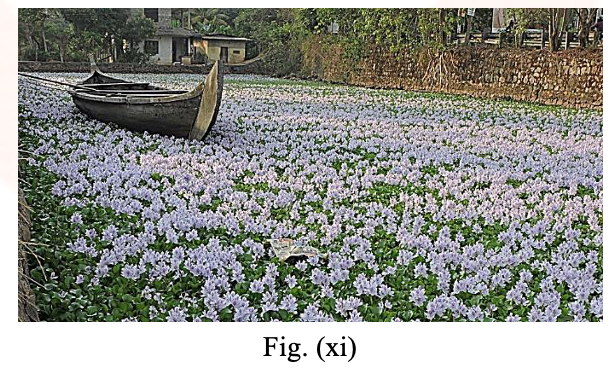
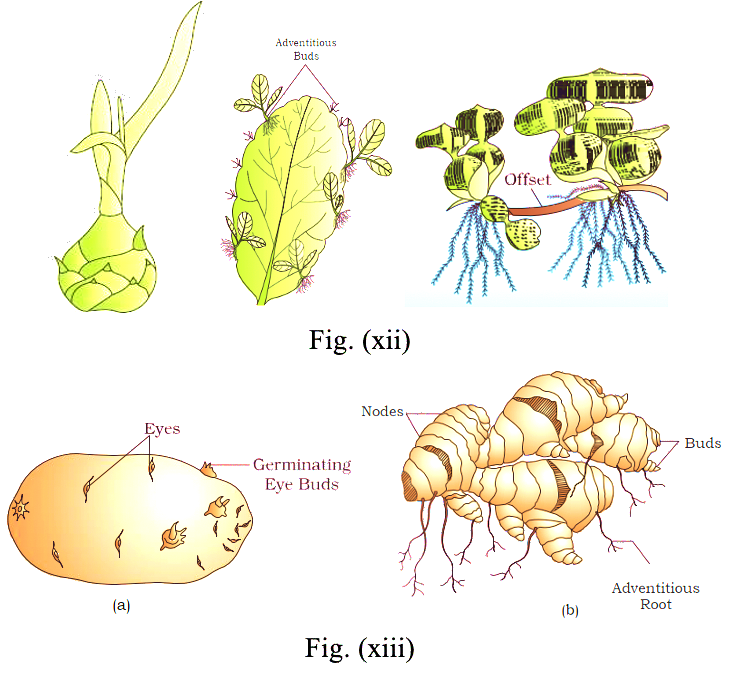
SEXUAL REPRODUCTION
- Sexual reproduction involves formation of the male and female gametes. These gametes fuse to form the zygote which develops to form the new organism.
- It is an elaborate, complex and slow process as compared to asexual reproduction.
- Juvenile phase : The phase from birth till they reach a certain stage of growth and maturity in their life, before they can reproduce sexually.
→ It is known as vegetative phase in plants. - Bamboo species flower only once in their life time, generally after 50-100 years, produce large number of fruits and die.
- Strobilanthes kunthiana (neelakuranji), flowers once in 12 years. As many of you would know, this plant flowered during September-October 2006.
- The females of placental mammals exhibit cyclical changes in the activities of ovaries and accessory ducts as well as hormones during the reproductive phase. In non-primate mammals like cows, sheep, rats, deers, dogs, tiger, etc., such cyclical changes during reproduction are called oestrus cycle where as in primates (monkeys, apes, and humans) it is called menstrual cycle.
- The events occurring during sexual reproduction are sequentially grouped into three distinct stages namely, the pre-fertilisation, fertilisation and the post-fertilisation events.
- These include all the events of sexual reproduction prior to the fusion of gametes. The two main pre-fertilisation events are gametogenesis and gamete transfer.
- Gametogenesis refers to the process of formation of the two types of gametes – male and female. Gametes are haploid cells.
- In some algae the two gametes are so similar in appearance that it is not possible to categorise them into male and female gametes. They are hence called homogametes (isogametes).
- In most of the sexually reproducing organisms the gametes produced are of two morphologically distinct types (heterogametes). In such organisms the male gamete is called the antherozoid or sperm and the female gamete is called the egg or ovum.
- Homothallic and monoecious are used to denote the bisexual condition and heterothallic and dioecious are the terms used to describe unisexual condition.
- In flowering plants, the unisexual male flower is staminate, i.e., bearing stamens, while the female is pistillate or bearing pistils.
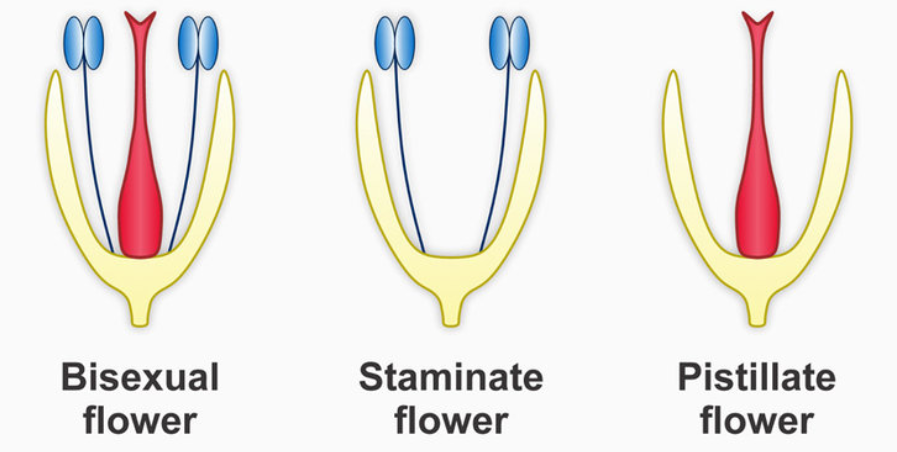
In some flowering plants, both male and female flowers may be present on the same individual (monoecious, ex : Cucurbits and Coconuts) or on separate individuals (dioecious, ex : Papaya and Date Palm). - Earthworms, sponge, tapeworm and leech, typical examples of bisexual animals that possess both male and female reproductive organs, are hermaphrodites.
- Cockroach is an example of a unisexual species.
- After their formation, male and female gametes must be physically brought together to facilitate fusion (fertilisation).
- In seed plants, pollen grains are the carriers of male gametes and ovules have the egg.
- Pollination means transfer of pollen grains from anther to the stigma.
- Pollen grains germinate on the stigma and the pollen tubes carrying the male gametes reach the ovule and discharge male gametes near the egg.
- Successful transfer and coming together of gametes is essential for the most critical event in sexual reproduction , the fertilisation.
- Fusion of gametes is called called syngamy which results in the formation of a diploid zygote.
Syngamy is the fusion of two gametes to form a zygote while fertilization is the act or process of rendering fertile. - Parthenogenesis : Formation of new individual from female egg without the fertilisation. This phenomenon has been reported in some organisms like rotifers, honeybees and even some lizards and birds (turkey).
- External Fertilisation : In most aquatic organisms, such as a majority of algae and fishes as well as amphibians, syngamy occurs in the external medium (water), i.e., outside the body of the organism. This type of gametic fusion is called external fertilisation.
- Internal Fertilisation : In case of fungi, and other higher animals such as reptiles, birds, mammals and in a majority of plants (bryophytes, pteridophytes, gymnosperms and angiosperms), syngamy occurs inside the body of the organism, hence the process is called internal fertilisation.
- THE ZYGOTE : Formation of the diploid zygote is universal in all sexually reproducing organisms.
- EMBRYOGENESIS : Embryogenesis refers to the process of development of embryo from the zygote.
- In oviparous animals like reptiles and birds, the fertilised eggs covered by hard calcareous shell are laid in a safe place in the environment; after a period of incubation young ones hatch out.
- In viviparous animals (majority of mammals including human beings), the zygote develops into a young one inside the body of the female organism. After attaining a certain stage of growth, the young ones are delivered out of the body of the female organism.
- Because of proper embryonic care and protection, the chances of survival of young ones is greater in viviparous organisms.
- In Plants : The zygote develops into the embryo and the ovules develop into the seed. The ovary develops into the fruit which develops a thick wall called pericarp that is protective in function. After dispersal, seeds germinate under favourable conditions to produce new plants.
- A few events occurring in plants after fertilisation are shown in the pic below :
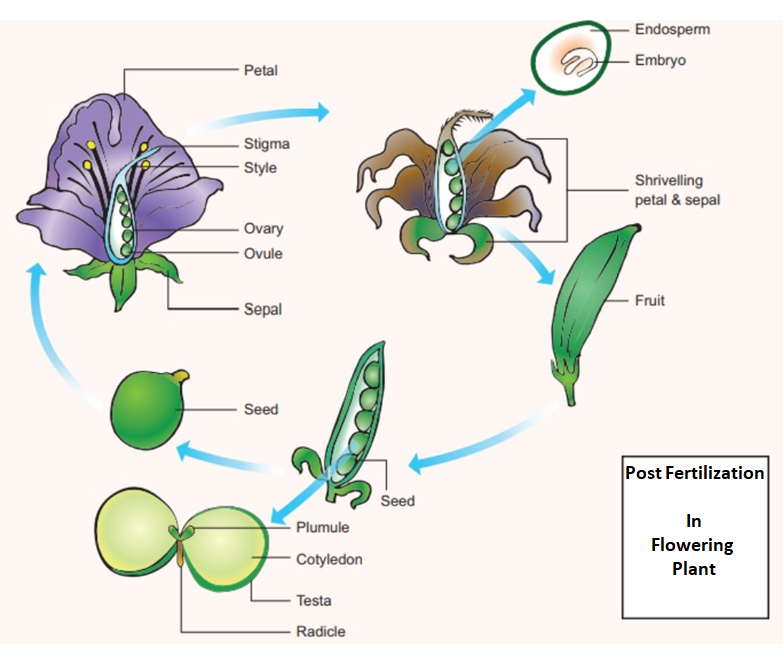
1.) Pre-fertilisation Events
A.) Gametogenesis


B.) Gamete Transfer
2.) Fertilisation
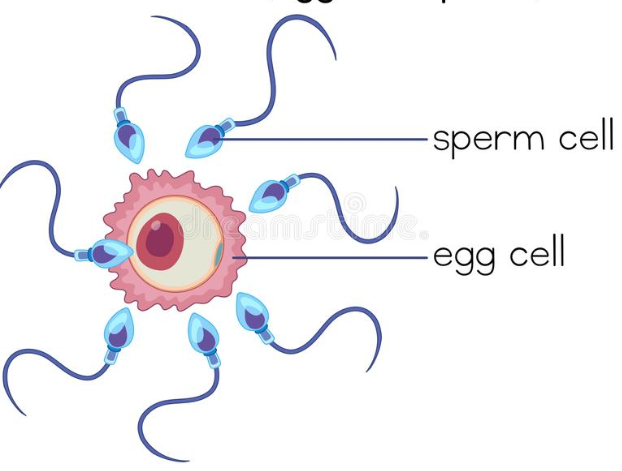
3.) Post-Fertilisation Events
Events in sexual reproduction after the formation of zygote are called post-fertilisation events.
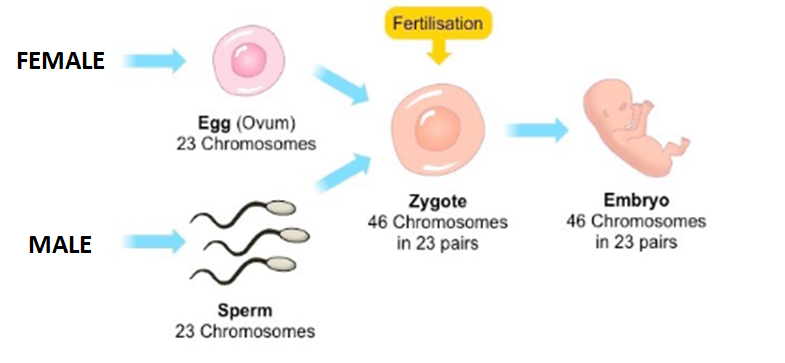
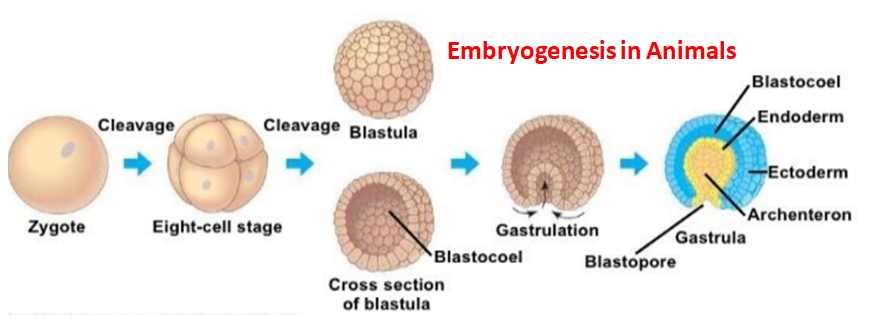
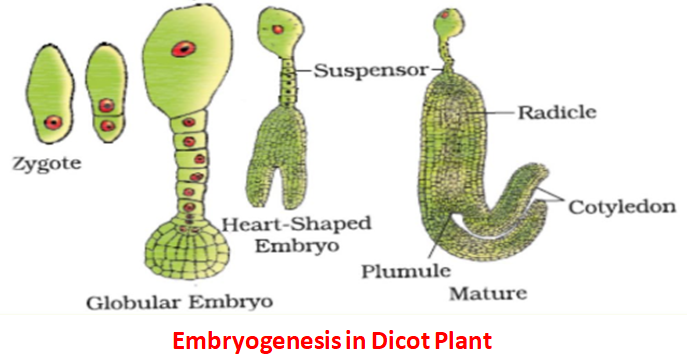
ASEXUAL REPRODUCTION
- A single parent in involved thus the offsprings are identical copies of their parent cells thus they are sometimes known as clones (morphologically and genetically similar individuals).
- Asexual reproduction is common among single-celled organisms, and in plants and animals with relatively simple organisations.
- In Protists and Monerans, during reproduction the single cell splits/divides into new daughter cells (offsprings) that is in these organisms cell division is itself a mode of reproduction.
- Principle forms of asexual reproduction are :
- Binary fission
- Multiple fission
- Gemmulation
- Budding
- Fragmentation
- Binary Fission : This is the simplest and most common method of asexual reproduction particularly seen in unicellular organisms occurring under favourable conditions of the environment such as availability of nutrients and other growth factors. After the organism attains full size, the parent divides into two daughter cells which are genetically and morphologically similar i.e., clones.
- Simple Binary Fission : This type of binary fission occurs in the irregular-shaped organisms such as Amoeba and the plane of division is difficult to ascertain. Binary means 2 and fission means splitting so the parent cell literally splits into two daughter cells.
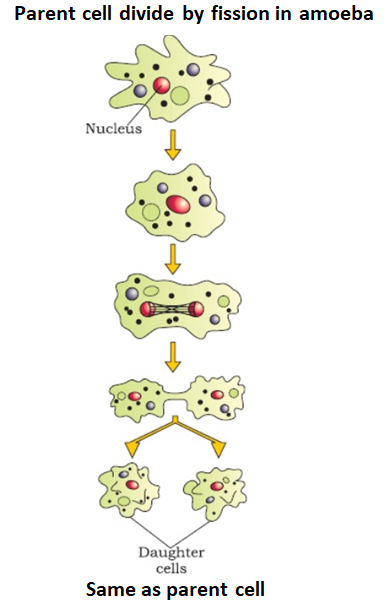
- Transverse Binary Fission: in this case the plane of division is at right angle to the long axis of the animal. Ex : Paramecium & Planaria .
- Longitudinal Binary Fission : plane of fission is parallel to the long axis. Ex : Euglena, Vorticella and in some corals.

- Under unfavourable condition the Amoeba withdraws its pseudopodia and secretes a three-layered hard covering or cyst around itself. This phenomenon is termed as encystation. When favourable conditions return, the encysted Amoeba divides by multiple fission and produces many minute amoebae or pseudopodiospores; the cyst wall bursts out, and the spores are liberated in the surrounding medium to grow up into many amoebae. This phenomenon is known as sporulation. And comes under the next subheading : Multiple fission
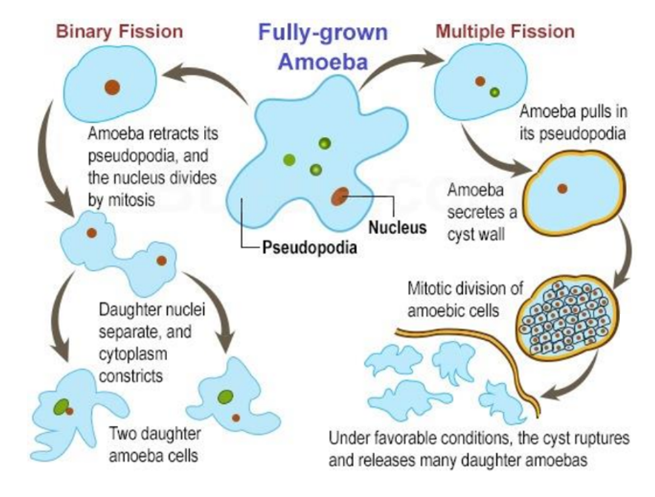
- Multiple Fission : The parent nucleus undergoes repeated divisions to form a large number of daughter nuclei followed by the division of the cytoplasm. As a result a number of daughter cells are formed from a single parent cell at the same time. This process usually takes place under unfavorable environmental conditions. The multiple fissions occur in most algae, fungi and some protozoans, e.g., Amoeba, Plasmodium (malaria parasite) etc.

- Gemmulation : In this case buds are formed within the parent body and are called gemmules. These are also called endogenous buds or internal buds. Ex : Sponges

- Budding : During the process of bud formation or budding an outgrowth or bud appears on the parent body. The bud may be unicellular or multicellular. The bud develops to its full size either after detachment from the parent or prior to detachment being attached to its parent body. Budding may be external or exogenous as in Hydra, Yeast or internal or endogenous as in Acinata.

- Fragmentation : In this mode of reproduction the parent cell is divided into many fragments and each fragment develops into a new organism. Ex :Spirogyra, Planaria


- Other Common Asexual Structures : Members of the Kingdom Fungi and simple plants such as algae reproduce through special asexual reproductive structures of which the most common structures are zoospores that usually are microscopic motile structures. Other common asexual reproductive structures are conidia (Penicillium), buds (Hydra) and gemmules (sponge).
- This method of asexual reproduction involves the vegetative structures (non-sexual parts) of plants like stem, roots and leaves. So reproduction by these structures is known as vegetative reproduction.
- Types of vegetative reproduction :
- Cutting: A part of a plant like stem or leaf, is cut off and planted. Ex : Rose

- Grafting: In grafting, the part to be grafted (scion) is attached to the stem of another plant that remains rooted in the ground (stock).

- Layering : Branches of plant are bend so that they can touch the ground and the part touching the ground develops adventitious roots and a new plant starts at that site.

- In plants, the units of vegetative propagation such as runner, rhizome, sucker, tuber, offset, bulb are all capable of giving rise to new offspring. -Details of these offsets, bulbs and other vegetative structures are really not that important

Fig : Vegetative propagules in angiosperms: (a) Eyes of potato; (b) Rhizome of ginger; (c) Bulbil of Agave; (d) Leaf buds of Bryophyllum; (e) Offset of water hyacinth. - Cutting: A part of a plant like stem or leaf, is cut off and planted. Ex : Rose
MEANS OF ASEXUAL REPRODUCTION
Types of binary fission :
What Does Amoeba Do Under Unfavourable Conditions?

VEGETATIVE PROPAGATION
ASEXUAL REPRODUCTION
- A single parent in involved thus the offsprings are identical copies of their parent cells thus they are sometimes known as clones (morphologically and genetically similar individuals).
- Asexual reproduction is common among single-celled organisms, and in plants and animals with relatively simple organisations.
- In Protists and Monerans, during reproduction the single cell splits/divides into new daughter cells (offsprings) that is in these organisms cell division is itself a mode of reproduction.
- Principle forms of asexual reproduction are :
- Binary fission
- Multiple fission
- Gemmulation
- Budding
- Fragmentation
- Binary Fission : This is the simplest and most common method of asexual reproduction particularly seen in unicellular organisms occurring under favourable conditions of the environment such as availability of nutrients and other growth factors. After the organism attains full size, the parent divides into two daughter cells which are genetically and morphologically similar i.e., clones.
- Simple Binary Fission : This type of binary fission occurs in the irregular-shaped organisms such as Amoeba and the plane of division is difficult to ascertain. Binary means 2 and fission means splitting so the parent cell literally splits into two daughter cells.

- Transverse Binary Fission: in this case the plane of division is at right angle to the long axis of the animal. Ex : Paramecium & Planaria .
- Longitudinal Binary Fission : plane of fission is parallel to the long axis. Ex : Euglena, Vorticella and in some corals.

- Under unfavourable condition the Amoeba withdraws its pseudopodia and secretes a three-layered hard covering or cyst around itself. This phenomenon is termed as encystation. When favourable conditions return, the encysted Amoeba divides by multiple fission and produces many minute amoebae or pseudopodiospores; the cyst wall bursts out, and the spores are liberated in the surrounding medium to grow up into many amoebae. This phenomenon is known as sporulation. And comes under the next subheading : Multiple fission

- Multiple Fission : The parent nucleus undergoes repeated divisions to form a large number of daughter nuclei followed by the division of the cytoplasm. As a result a number of daughter cells are formed from a single parent cell at the same time. This process usually takes place under unfavorable environmental conditions. The multiple fissions occur in most algae, fungi and some protozoans, e.g., Amoeba, Plasmodium (malaria parasite) etc.

- Gemmulation : In this case buds are formed within the parent body and are called gemmules. These are also called endogenous buds or internal buds. Ex : Sponges

- Budding : During the process of bud formation or budding an outgrowth or bud appears on the parent body. The bud may be unicellular or multicellular. The bud develops to its full size either after detachment from the parent or prior to detachment being attached to its parent body. Budding may be external or exogenous as in Hydra, Yeast or internal or endogenous as in Acinata.

- Fragmentation : In this mode of reproduction the parent cell is divided into many fragments and each fragment develops into a new organism. Ex :Spirogyra, Planaria


- Other Common Asexual Structures : Members of the Kingdom Fungi and simple plants such as algae reproduce through special asexual reproductive structures of which the most common structures are zoospores that usually are microscopic motile structures. Other common asexual reproductive structures are conidia (Penicillium), buds (Hydra) and gemmules (sponge).
- This method of asexual reproduction involves the vegetative structures (non-sexual parts) of plants like stem, roots and leaves. So reproduction by these structures is known as vegetative reproduction.
- Types of vegetative reproduction :
- Cutting: A part of a plant like stem or leaf, is cut off and planted. Ex : Rose

- Grafting: In grafting, the part to be grafted (scion) is attached to the stem of another plant that remains rooted in the ground (stock).

- Layering : Branches of plant are bend so that they can touch the ground and the part touching the ground develops adventitious roots and a new plant starts at that site.

- In plants, the units of vegetative propagation such as runner, rhizome, sucker, tuber, offset, bulb are all capable of giving rise to new offspring. -Details of these offsets, bulbs and other vegetative structures are really not that important

Fig : Vegetative propagules in angiosperms: (a) Eyes of potato; (b) Rhizome of ginger; (c) Bulbil of Agave; (d) Leaf buds of Bryophyllum; (e) Offset of water hyacinth. - Cutting: A part of a plant like stem or leaf, is cut off and planted. Ex : Rose
MEANS OF ASEXUAL REPRODUCTION
Types of binary fission :
What Does Amoeba Do Under Unfavourable Conditions?

VEGETATIVE PROPAGATION
ASEXUAL REPRODUCTION
- A single parent in involved thus the offsprings are identical copies of their parent cells thus they are sometimes known as clones (morphologically and genetically similar individuals).
- Asexual reproduction is common among single-celled organisms, and in plants and animals with relatively simple organisations.
- In Protists and Monerans, during reproduction the single cell splits/divides into new daughter cells (offsprings) that is in these organisms cell division is itself a mode of reproduction.
- Principle forms of asexual reproduction are :
- Binary fission
- Multiple fission
- Gemmulation
- Budding
- Fragmentation
- Binary Fission : This is the simplest and most common method of asexual reproduction particularly seen in unicellular organisms occurring under favourable conditions of the environment such as availability of nutrients and other growth factors. After the organism attains full size, the parent divides into two daughter cells which are genetically and morphologically similar i.e., clones.
- Simple Binary Fission : This type of binary fission occurs in the irregular-shaped organisms such as Amoeba and the plane of division is difficult to ascertain. Binary means 2 and fission means splitting so the parent cell literally splits into two daughter cells.

- Transverse Binary Fission: in this case the plane of division is at right angle to the long axis of the animal. Ex : Paramecium & Planaria .
- Longitudinal Binary Fission : plane of fission is parallel to the long axis. Ex : Euglena, Vorticella and in some corals.

- Under unfavourable condition the Amoeba withdraws its pseudopodia and secretes a three-layered hard covering or cyst around itself. This phenomenon is termed as encystation. When favourable conditions return, the encysted Amoeba divides by multiple fission and produces many minute amoebae or pseudopodiospores; the cyst wall bursts out, and the spores are liberated in the surrounding medium to grow up into many amoebae. This phenomenon is known as sporulation. And comes under the next subheading : Multiple fission

- Multiple Fission : The parent nucleus undergoes repeated divisions to form a large number of daughter nuclei followed by the division of the cytoplasm. As a result a number of daughter cells are formed from a single parent cell at the same time. This process usually takes place under unfavorable environmental conditions. The multiple fissions occur in most algae, fungi and some protozoans, e.g., Amoeba, Plasmodium (malaria parasite) etc.

- Gemmulation : In this case buds are formed within the parent body and are called gemmules. These are also called endogenous buds or internal buds. Ex : Sponges

- Budding : During the process of bud formation or budding an outgrowth or bud appears on the parent body. The bud may be unicellular or multicellular. The bud develops to its full size either after detachment from the parent or prior to detachment being attached to its parent body. Budding may be external or exogenous as in Hydra, Yeast or internal or endogenous as in Acinata.

- Fragmentation : In this mode of reproduction the parent cell is divided into many fragments and each fragment develops into a new organism. Ex :Spirogyra, Planaria


- Other Common Asexual Structures : Members of the Kingdom Fungi and simple plants such as algae reproduce through special asexual reproductive structures of which the most common structures are zoospores that usually are microscopic motile structures. Other common asexual reproductive structures are conidia (Penicillium), buds (Hydra) and gemmules (sponge).
- This method of asexual reproduction involves the vegetative structures (non-sexual parts) of plants like stem, roots and leaves. So reproduction by these structures is known as vegetative reproduction.
- Types of vegetative reproduction :
- Cutting: A part of a plant like stem or leaf, is cut off and planted. Ex : Rose

- Grafting: In grafting, the part to be grafted (scion) is attached to the stem of another plant that remains rooted in the ground (stock).

- Layering : Branches of plant are bend so that they can touch the ground and the part touching the ground develops adventitious roots and a new plant starts at that site.

- In plants, the units of vegetative propagation such as runner, rhizome, sucker, tuber, offset, bulb are all capable of giving rise to new offspring. -Details of these offsets, bulbs and other vegetative structures are really not that important

Fig : Vegetative propagules in angiosperms: (a) Eyes of potato; (b) Rhizome of ginger; (c) Bulbil of Agave; (d) Leaf buds of Bryophyllum; (e) Offset of water hyacinth. - Cutting: A part of a plant like stem or leaf, is cut off and planted. Ex : Rose
MEANS OF ASEXUAL REPRODUCTION
Types of binary fission :
What Does Amoeba Do Under Unfavourable Conditions?

VEGETATIVE PROPAGATION
SEXUAL REPRODUCTION
- Sexual reproduction involves formation of the male and female gametes, either by the same individual or by different individuals of the opposite sex. These gametes fuse to form the zygote which develops to form the new organism. It is an elaborate, complex and slow process as compared to asexual reproduction. Because of the fusion of male and female gametes, sexual reproduction results in offspring that are not identical to the parents or amongst themselves.
- All organisms have to reach a certain stage of growth and maturity in their life, before they can reproduce sexually. That period of growth is called the juvenile phase. It is known as vegetative phase in plants. This phase is of variable durations in different organisms. The end of juvenile/vegetative phase which marks the beginning of the reproductive phase can be seen easily in the higher plants when they come to flower.
- Depending upon the age plants are of three types,
- Annual – The plant which completes its life cycle within one year and then dies. Eg. Peas
- Biennial - The plant which completes its biological life cycle two years. Eg. Onion
- Perennial - The plant that lives for more than two years. Eg. Banana, Mango
- Usually it is very difficult to find out time of flowering in Perennial plants, some plants exhibit unusual phenomenon.
- Unusual Phenomenon of Some Flowering Plants
- Bamboo species flower only once in their life time, generally after 50-100 years, produce large number of fruits and die.
- Strobilanthus kunthiana (neelakuranji) flowers once in 12 years. The plant flowered during September-October 2018.
- Breeding of Animals : On the basis of time of breeding, animals are of two types:-
- Seasonal Breeders: They reproduce at particular period the year such as frog, lizards, most deer, etc.
- Continuous Breeders: These animals continue to breed throughout their sexual maturity. Examples are honey bee, queen, poultry, rabbit, mice, cattle, etc.
- Breeding of Animals

- Ovulation occurs at the ovary surface and is described as the process in which an oocyte (female germ cell) is released from the follicle. Ovulation is a non-deleterious 'inflammatory response' which is initiated by a luteinizing hormone (LH) surge. The mechanism of ovulation varies between species.

- Spontaneous ovulation is the ovulatory process in which the maturing ovarian follicles secrete ovarian steroids to generate pulsatile GnRH (the neuropeptide which controls all vertebrate reproductive function) release into the median eminence (the area which connects the hypothalamus to the anterior pituitary gland) to ultimately cause a pre-ovulatory LH surge. Spontaneously ovulating species go through menstrual cycles and are fertile at certain times based on what part of the cycle they are in. Species in which the females are spontaneous ovulators include Rats, Mice, Guinea pigs, Horse, Pigs, Sheep, Monkeys, and Humans.
- Induced ovulation is the process in which the pre-ovulatory LH surge and therefore ovulation is induced by some component of coitus e.g. receipt of genital stimulation. Usually, spontaneous steroid-induced LH surges are not observed in induced ovulator species throughout their reproductive cycles, which indicates that GnRH release is absent or reduced due to lack of positive feedback action from steroid hormones. Species in which the females are induced ovulators include Cats, Rabbits, Ferrets, and Camels.

- Events in sexual reproduction : After attainment of maturity, all sexually reproducing organisms exhibit events and processes that have remarkable fundamental similarity, even though the structures associated with sexual reproduction are indeed very different. The events of sexual reproduction though elaborate and complex, follow a regular sequence. Sexual reproduction is characterised by the fusion (or fertilisation) of the male and female gametes, the formation of zygote and embryogenesis. For convenience these sequential events may be grouped into three distinct stages namely,
- Pre-fertilisation
- Fertilisation
- Post-fertilisation
- These include all the events of sexual reproduction prior to the fusion of gametes. The two main pre-fertilisation events are gametogenesis and gamete transfer.
- Gametogenesis
- Gamete transfer
- Gametogenesis - The process of formation of male and female gametes. Gametes may be :
- Homogametes or isogametes- the two gametes similar in appearance ,can not categorise into male and female gametes. eg. Cladophora
- Heterogametes - two morphologically distinct gametes.
- Male gamete is called antherozoid or sperm.
- Female gamete is called the egg or ovum. eg. Fucus, Human being
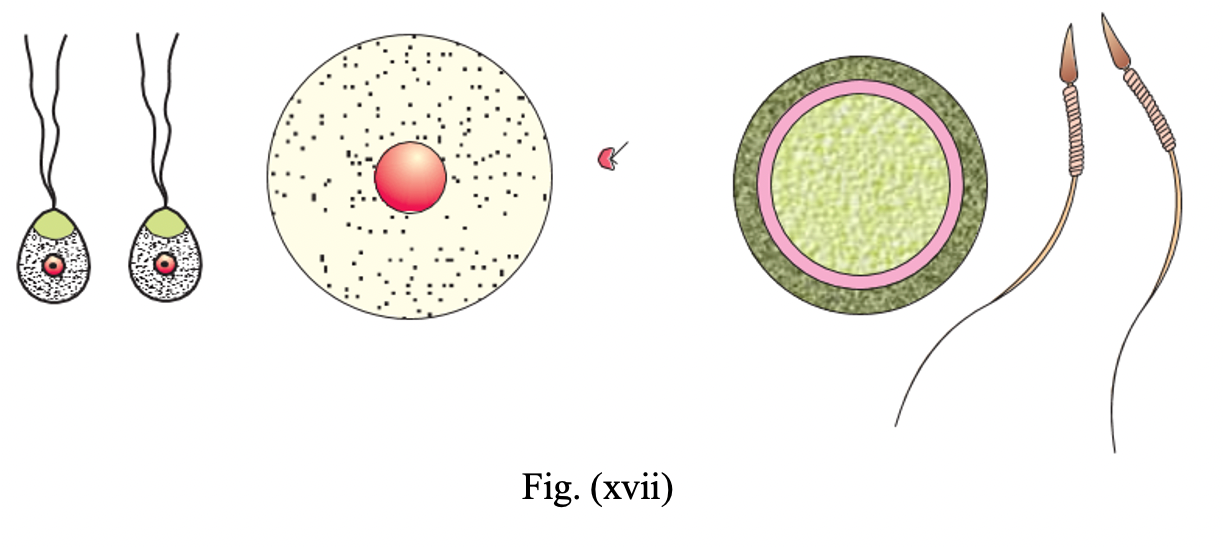
- Sexual reproduction in organisms generally involves the fusion of gametes from two different individuals.
- Homothallic and monoecious - terms used to describe bisexual condition of plant.
- Heterothallic and dioecious - terms used to describe unisexual condition of plant.
- Staminate - unisexual male flower bearing stamens
- Pistillate - unisexual female flower bearing stamens.
- Monoecious - both male and female flowers may be present on the same individual. Eg. cucurbits and coconuts
- Dioecious - both male and female flowers may be present on separate individuals. Eg. papaya and date palm
- Diversity of sexuality in organisms
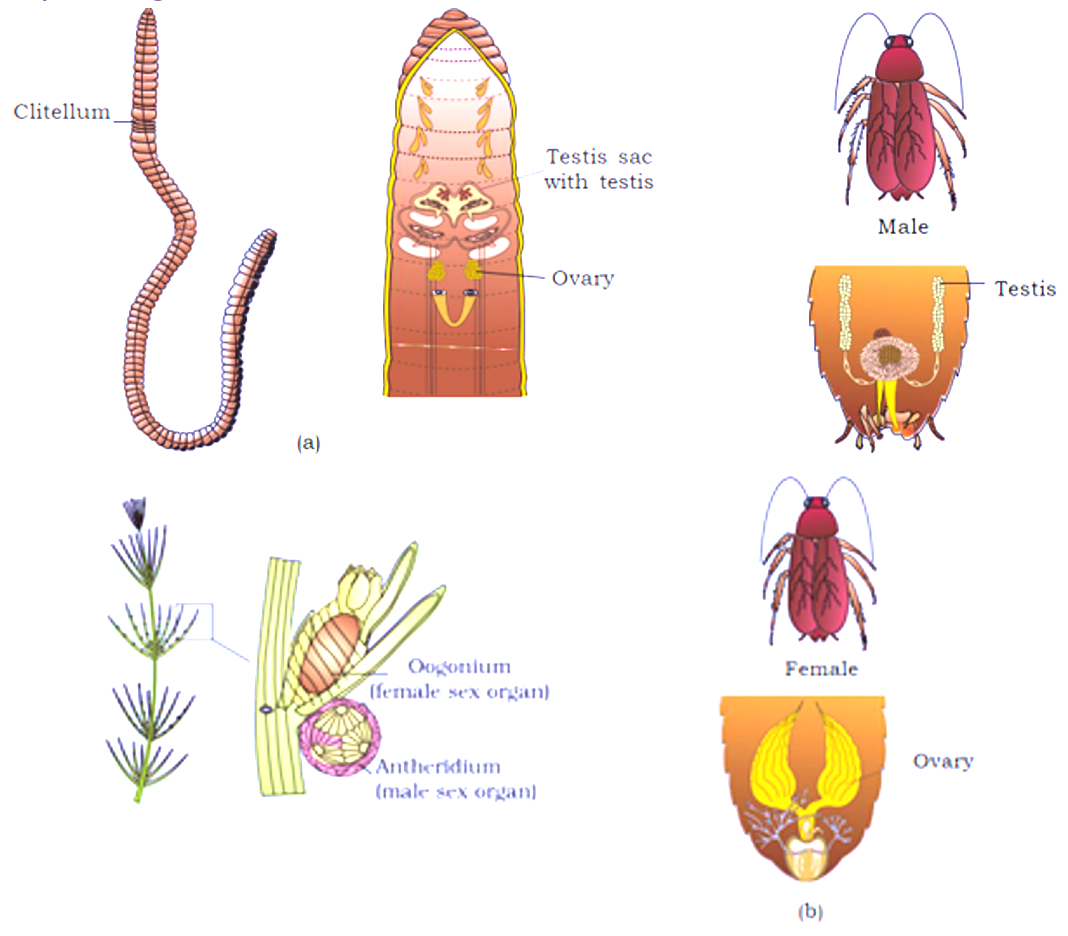
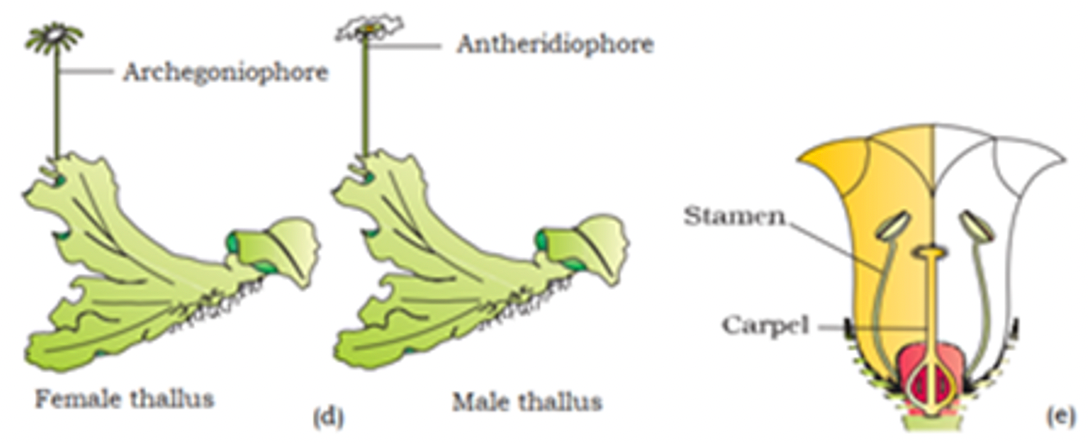
Diversity of sexuality in organisms (a) Bisexual animal (Earthworm); (b) Unisexual animal (Cockroach); (c) Monoecious plant (Chara); (d) Diecious plant (Marchantia); (e) Bisexual flower (sweet potato)
Sexuality in Plants :
Cell division during Gamete Formation - Parental body of organisms like monera, fungi, algae and bryophytes is haploid. They produce gametes by mitotic division.
- Parental body of organisms like pteridophytes, gymnosperms, angiosperms and most of the animals including human beings is diploid. They produce gametes by meiotic cell division.
- In diploid organisms, specialised cells called meiocytes (gamete mother cell) undergo meiosis.
- After their formation, male and female gametes must be physically brought together to facilitate fusion (fertilisation).
- In majority organisms male gamete is motile where as female is stationary.
- Exceptions , a few fungi and algae both types of gametes are motile.
- A medium is required through which the male gametes move.
- In algae, bryophytes and pteridophytes, water is the medium for gamete transfer.
- To compensate loss of male gametes during transport, the number of male gametes produced is several thousand times the number of female gametes produced.
- Pollination – The transfer of pollen grains from anther to the stigma is called pollination.
- Self-pollination and Cross pollination
- Pollen grains germinate on the stigma and the pollen tubes carrying the male gametes reach the ovule and discharge male gametes near the synergids.

Germination of Pollen grain on Stigma of a Flower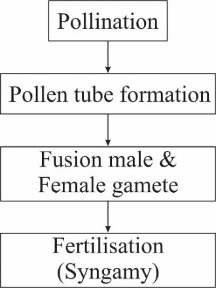
Fertilisation - Fertilisation results the formation of diploid zygote.
- Parthenogenesis - Some female gametes undergo the development new organisms without fertilisation. This phenomenon is called parthenogenesis.
- Eg. Rotifers, Honey bees, and Turkey birds
- Parthenogenesis is a form of reproduction in which an egg can develop into an embryo without being fertilized by a sperm. Parthenogenesis is derived from the Greek words for “Virgin birth,” and several insect species including aphids, bees, and ants are known to reproduce by parthenogenesis. Recently, parthenogenesis has received considerable attention as a tool for the production of stem cells. Human stem cells derived from embryos, fetal primordial germ cells, umbilical cord blood, and adult tissues provide potential cell based therapies for repair of degenerating or damaged tissues.
- Parthenogenesis is of two types,
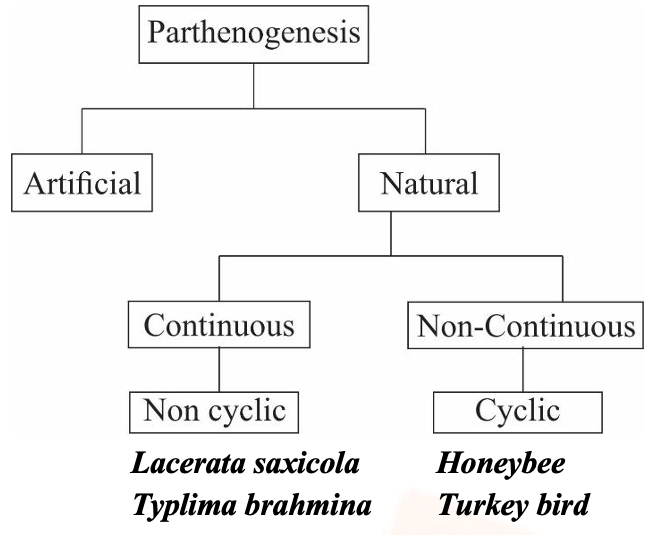
- Haploid Parthenogenesis or Arrhenotoky: In Hymenoptera, Coleoptera, Thysanoptera, Rotifera and Arachinida male arises from the unfertilized egg and are consequently haploid, while females from fertilized eggs and so are diploid.
- Diploid Parthenogenesis or Thelytoky: Here the reduction division is abortive and diploid eggs are formed which develop without fertilization. This is again of two types:

- In some Crustaceans, Hymenoptera and Lepidoptera during oogenesis, development of eggs takes place following some anamoly in reduction division thereby diploid ovum is produced which develop into diploid individual.
- In some Crustaceans and Molluscs the first meiotic division which is a reduction division is completely suppressed and only a mitotic division resulting in diploid eggs which develop into new individuals without fertilization. It is also known as Apomeiotic parhthenogenesis.
- A form of asexual reproduction related to parthenogenesis is gynogenesis. Here, offspring are produced by the same mechanism as in parthenogenesis, but with the requirement that the egg merely be stimulated by the presence of sperm in order to develop. However, the sperm cell does not contribute any genetic material to the offspring. Since gynogenetic species are all female, activation of their eggs requires mating with males of a closely related species for the needed stimulus. Some salamanders of the genus Ambystoma are gynogenetic and appear to have been so for over a million years.

- Types of Fertilisation
- External Fertilisation (Syngamy outside the body of organism) Eg. algae, fishes and amphibians
- Internal Fertilisation (Syngamy inside the body of organism)
- Eg. Fungi, Reptiles, Birds, Mammals
- Post-fertilisation Events
- Events in sexual reproduction after the formation of zygote are called post-fertilisation events.
- Formation of the diploid zygote
- In organisms belonging to fungi and algae, zygote develops a thick wall that is resistant to dessication and damage.
- It undergoes a period of rest before germination.
- Embryogenesis refers to the process of development of embryo from the zygote. During embryogenesis, zygote undergoes cell division (mitosis) and cell differentiation. While cell divisions increase the number of cells in the developing embryo; cell differentiation helps groups of cells to undergo certain modifications to form specialised tissues and organs to form an organism.
- Animals are categorised into oviparous and viviparous based on whether the development of the zygote takes place outside the body of the female parent or inside, i.e., whether they lay fertilised/unfertilised eggs or give birth to young ones. In oviparous animals like reptiles and birds, the fertilised eggs covered by hard calcareous shell are laid in a safe place in the environment; after a period of incubation young ones hatch out. On the other hand, in viviparous animals (majority of mammals including human beings), the zygote develops into a young one inside the body of the female organism. After attaining a certain stage of growth, the young ones are delivered out of the body of the female organism. Because of proper embryonic care and protection, the chances of survival of young ones is greater in viviparous organisms.
- Oviparous :Fertilised eggs are covered by hard calcareous shell which laid in a safe place in the environment and young ones hatch out after a period of incubation.
- ViviparousProper embryonic care and protection causes greater survival chances of young ones in viviparous organisms.
- Oviparous
- Eg. reptiles and birds
- Lay fertilised / unfertilised eggs

- Viviparous
- Eg. Mammals
- Give birth to young ones
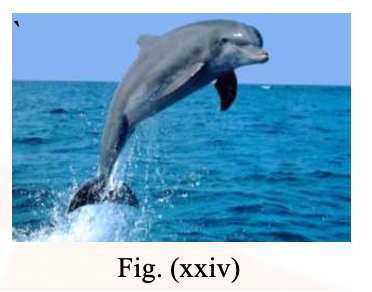
- Ovoviviparous
- Eg. Seahorse
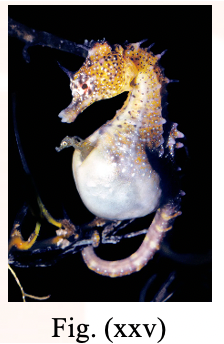
Development of Zygote
Zygote in Flowering Plant - In flowering plants, the zygote is formed inside the ovule. After fertilisation the sepals, petals and stamens of the flower wither and fall off. Can you name a plant in which the sepals remain attached? The pistil however, remains attached to the plant. The zygote develops into the embryo and the ovules develop into the seed. The ovary develops into the fruit which develops a thick wall called pericarp that is protective in function (Figure 1.8). After dispersal, seeds germinate under favourable conditions to produce new plants.
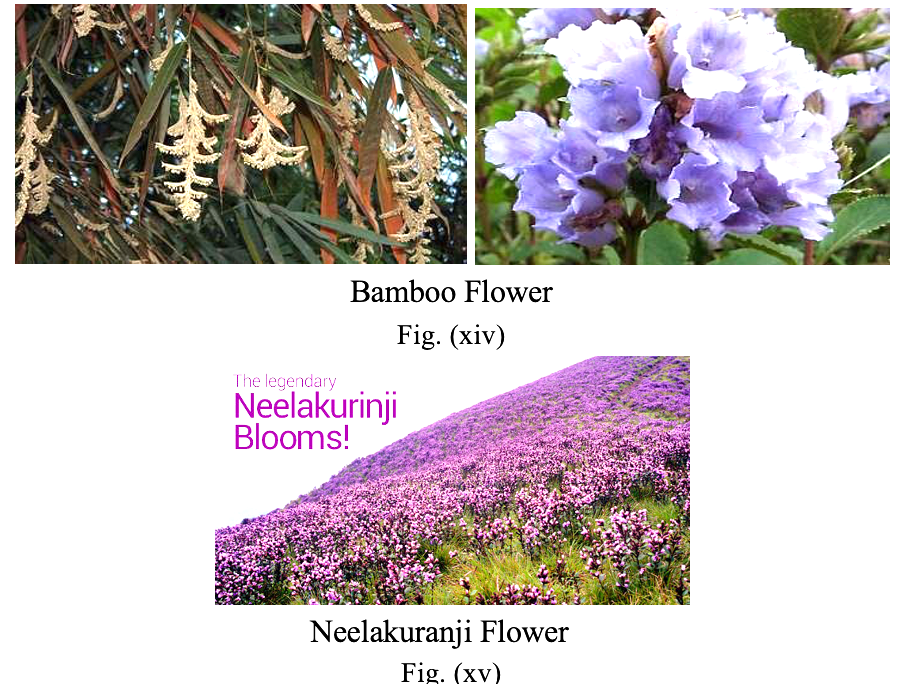
Ovulators :
Pre-fertilisation Events
Gametogenesis
Sexuality in Organisms
Life Cycle of Organisms
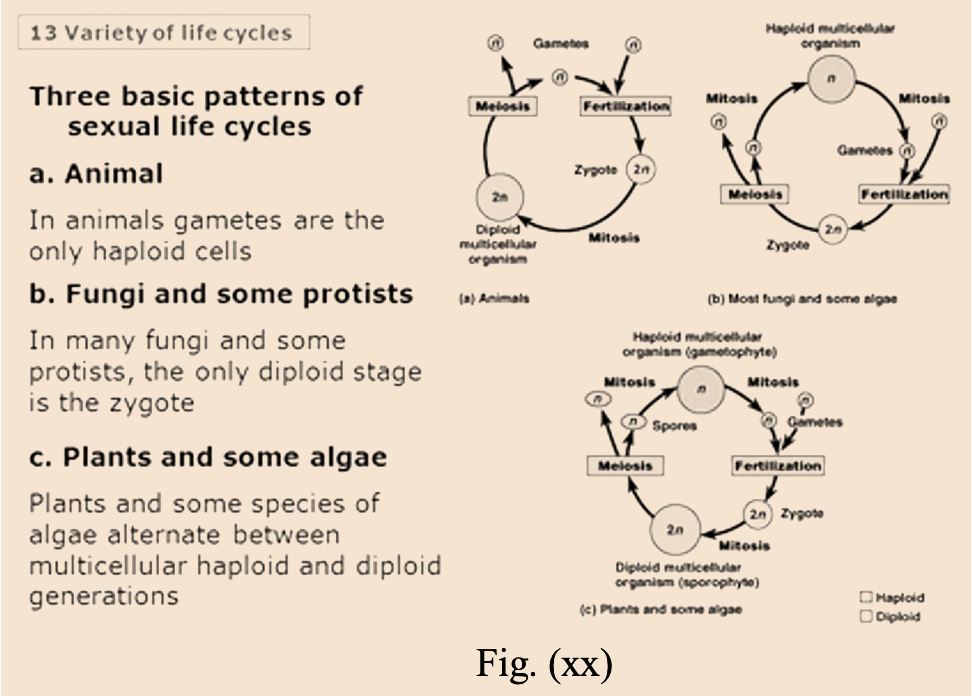
Table: Chromosome Numbers in Meiocytes (diploid, 2n) and Gametes (haploid, n) of Some Organisms. Fill in the Blank Spaces.
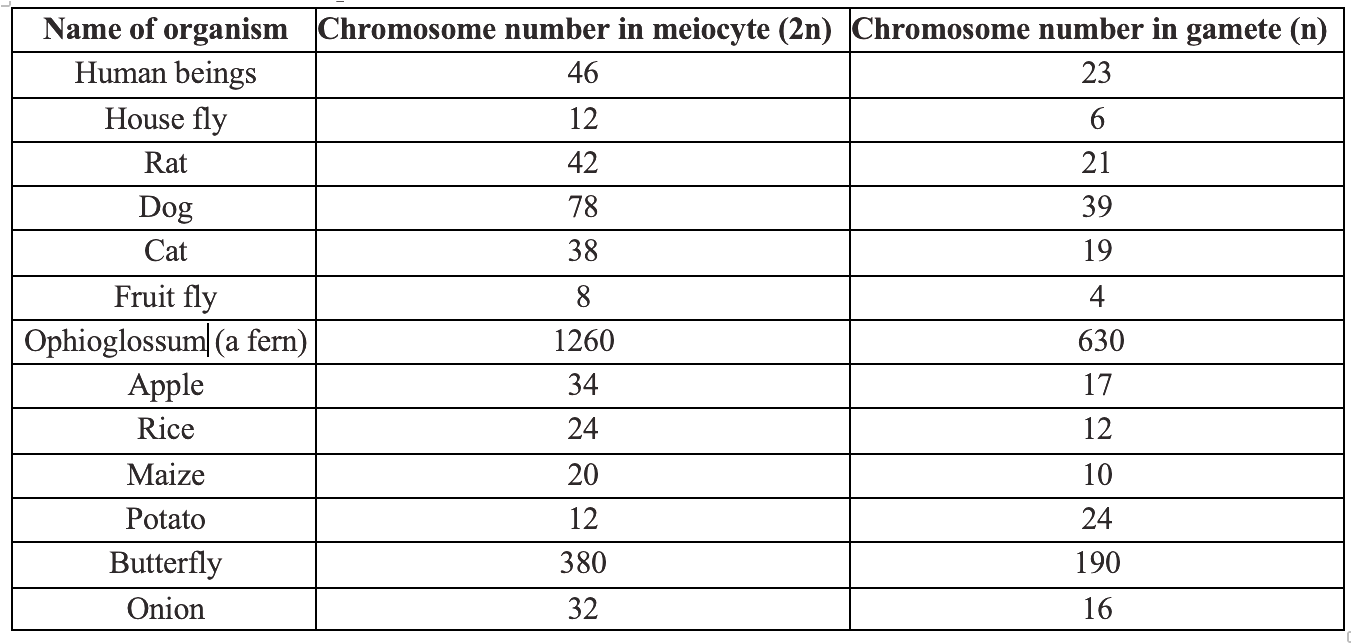
Gamete Transfer
POLLINATION
Parthenogenesis
Meiotic Parthenogenesis
Ameiotic Parthenogenesis
Gynogenesis
Events during Fertilisation
Embryogenesis
Types of Animals

SUMMARY
- Reproduction enables a species to live generation after generation. Reproduction in organisms can be broadly classified into asexual and sexual reproduction. Asexual reproduction does not involve the fusion of gametes. It is common in organisms that have a relatively simple organisation such as the fungi, algae and some invertebrate animals. The offspring formed by asexual reproduction are identical and can be referred to as clones. Zoospores, conidia, etc., are the most common asexual structures formed in several algae and fungi. Budding and gemmule formation are the common asexual methods seen in lower animals.
- Prokaryotes and unicellular organisms reproduce asexually by cell division or binary fission of the parent cell. In several aquatic and terrestrial species of angiosperms, structures such as runners, rhizomes, suckers, tubers, offsets, etc., are capable of giving rise to new offspring. This method of asexual reproduction is generally referred to as vegetative propagation.
- Sexual reproduction involves the formation and fusion of gametes. It is a complex and slower process as compared to asexual reproduction. Most of the higher animals reproduce almost entirely by sexual method. Events of sexual reproduction may be categorised into pre-fertilisation, fertilisation and post-fertilisation events. Pre-fertilisation events include gametogenesis and gamete transfer while post-fertilisation events include the formation of zygote and embryogenesis.
- Organisms may be bisexual or unisexual. Sexuality in plants is varied, particularly in angiosperms, due to the production of diverse types of flowers. Plants are defined as monoecious and dioecious. Flowers may be bisexual or unisexual flowers.
- Gametes are haploid in nature and usually a direct product of meiotic division except in haploid organisms where gametes are formed by mitosis.
- Transfer of male gametes is an essential event in sexual reproduction. It is relatively easy in bisexual organisms. In unisexual animals it occurs by copulation or simultaneous release. In angiosperms, a special process called pollination ensures transfer of pollen grains which carry the pollen grains to the stigma.
- Syngamy (fertilisation) occurs between the male and female gametes. Syngamy may occur either externally, outside the body of organisms or internally, inside the body. Syngamy leads to formation of a specialised cell called zygote.
- The process of development of embryo from the zygote is called embryogenesis. In animals, the zygote starts developing soon after its formation. Animals may be either oviparous or viviparous. Embryonal protection and care are better in viviparous organisms.
- In flowering plants, after fertilisation, ovary develops into fruit and ovules mature into seeds. Inside the mature seed is the progenitor of the next generation, the embryo.
SEXUAL REPRODUCTION
- Sexual reproduction me male and female gametes bante hain and they fuse to form a zygote fir zygote se new individual ki formation hoti hai.
- Kuch kuch organisms life me ek hi baar reproduce karte hain jaise ki bamboo plants and kuch bahur salo me ek baar, jaise ki neelakurangi plant jo ki 12 saal me ek baar flower karta hai.
- Females ke case me their reproductive organs and associated ducts, they undergo cyclical changes jaise ki kuch animals hote hai jo keval ek particular season me hi breed karte hai toh uss waqt females khud ko prepare karti hai for the conception. Iss preparationme uterus me bahut sare changes hote hain. Inhi changes ko non primate females me hum oestrous cycle kehte hain and primate females me hum inko menstrual cycle kehte hai.
- Sexual reproduction me 3 phases hote hain : pre-fertilisation events, fertilisation or fir aate hain post-fertilisation events.
- Pre fertilisation events me hota hai gamete ka formation and gamete ka transfer.
- Gametogenesis : gametes ka formation hi gametogenesis kehlata hai. Agar male and female gametes ki morphology similar hoti hai toh wo homogametes ya isogametes kehlate hain and agar dono dekhne me alag alag hote hai like size difference hai toh us case me hum inko heterogametes kehte hain. The word ‘homo’ and ‘iso’ are used in bio for “same”. Yani ki isogametes me iso ka matlab same hota hai and homogametes me homo ka matlab same hai vhi jo term hetero hai in heterogametes, uska matlab hai different.
- Homothallic and monoecious ka matlab hota hai bisexual condition or hermaphrodite vhin dusri or heterothallic and dioecious ka matlab hota hai unisexual condition.
- Next aata hai gametes ka transfer. Toh gamete ke transfer ke liye ek medium chahiye hota hai jiske through gametes move krke ek dusre ke pass aa paye. Plants me yeah process pollination ke under aati hai vhi animals me yeah process copulation ke under aati hai. Dono hi processes (copulation and pollination) ka ultimate goal hai : male gamete ko female gamete tak pahuchana qnki generally heterogametic conditions me male gametes smaller hote hain and they are mobile who jo female gamete hai wo larger and immobile hota hai toh usually male gamete ko female gamete tak jana pasta hai for the process of fertilisation.
- Syngamy is the fusion of male and female gametes.
- Aquatic organisms me external fertilisation hoti hai yani ki fertilisation organism ki body ke bahar hori hai toh most aquatic life forms me fertilisation paani me hora hoga. Ab paani me waves vgrah aati rhti hai toh its not a stable platform like the ground so what the aquatic organisms does is that they produce a large number of gametes taki agar kuch gametes aisey paani me diffuse off ho bhi gye toh a few of them will fertilise. Uper se in organisms me gamete ek sath release hote hain toh wo bhi fertilised eggs ka number increase kar deta hai. Secondly in organisms me zygote bahar hi bn rha hoga toh its quite prone to predators toh isilie bhi aquatic organisms jyada gamete bnate hain taki agar kuch zygotes ya early life me predators ka shikar ho gye toh there will be a few of them to reach till the reproductive age and ensure continuity of their species.
- Jab fertilisation body ki ander ho toh that is known as internal fertilisation jaisey ki humans vgarah me hota hai. Ab internal fertilisation is advantageous qnki mother ki body ke ander zygote hai toh it will be protected from harsh environmental conditions and from predators etc also. Moreover internal fertilisation ke case me females jyada gametes bhi produce ni karti.
- Fertilisation se zygote banta hai toh zygote ki jab growth and development hogi toh usme various stages aate hain considering ki bhyii plant hai ya animal ka life cycle ya fungi or bacteria ka. But generally multicellular organisms me zygote ke baad embryo banta hai and this step is known as embryogenesis. Zygote single cell ka hai but wo rapidly divide karta hai by mitosis to increase the number of cells and then wo cells grow karte hai and they eventually give gise to a new individual. Hume focus karna hai plants and humans pe jo ki aapke aane wale next 2 chapters me btaya jayega in detail.
- Plants ke post fertilisation events se generally question aata hai 3 marks me but yeah part apun next chapter me cover krenge toh vhaan aapko aache se samjh aa jayega but just to give you guys a gist, plant me (angiosperms) fertilisation ke baad seed banta hai, ovary ripe hokr fruit bn jati hai and flowers ke petals and sepals sukh kar fir jate hai.
So that was all about the basics sexual reproduction in organisms.
PRE-FERTILISATION EVENTS
FERTILISATION:
POST-FERTILISATION EVENTS
SEXUAL REPRODUCTION
- Sexual reproduction me male and female gametes bante hain and they fuse to form a zygote fir zygote se new individual ki formation hoti hai.
- Kuch kuch organisms life me ek hi baar reproduce karte hain jaise ki bamboo plants and kuch bahur salo me ek baar, jaise ki neelakurangi plant jo ki 12 saal me ek baar flower karta hai.
- Females ke case me their reproductive organs and associated ducts, they undergo cyclical changes jaise ki kuch animals hote hai jo keval ek particular season me hi breed karte hai toh uss waqt females khud ko prepare karti hai for the conception. Iss preparationme uterus me bahut sare changes hote hain. Inhi changes ko non primate females me hum oestrous cycle kehte hain and primate females me hum inko menstrual cycle kehte hai.
- Sexual reproduction me 3 phases hote hain : pre-fertilisation events, fertilisation or fir aate hain post-fertilisation events.
- Pre fertilisation events me hota hai gamete ka formation and gamete ka transfer.
- Gametogenesis : gametes ka formation hi gametogenesis kehlata hai. Agar male and female gametes ki morphology similar hoti hai toh wo homogametes ya isogametes kehlate hain and agar dono dekhne me alag alag hote hai like size difference hai toh us case me hum inko heterogametes kehte hain. The word ‘homo’ and ‘iso’ are used in bio for “same”. Yani ki isogametes me iso ka matlab same hota hai and homogametes me homo ka matlab same hai vhi jo term hetero hai in heterogametes, uska matlab hai different.
- Homothallic and monoecious ka matlab hota hai bisexual condition or hermaphrodite vhin dusri or heterothallic and dioecious ka matlab hota hai unisexual condition.
- Next aata hai gametes ka transfer. Toh gamete ke transfer ke liye ek medium chahiye hota hai jiske through gametes move krke ek dusre ke pass aa paye. Plants me yeah process pollination ke under aati hai vhi animals me yeah process copulation ke under aati hai. Dono hi processes (copulation and pollination) ka ultimate goal hai : male gamete ko female gamete tak pahuchana qnki generally heterogametic conditions me male gametes smaller hote hain and they are mobile who jo female gamete hai wo larger and immobile hota hai toh usually male gamete ko female gamete tak jana pasta hai for the process of fertilisation.
- Syngamy is the fusion of male and female gametes.
- Aquatic organisms me external fertilisation hoti hai yani ki fertilisation organism ki body ke bahar hori hai toh most aquatic life forms me fertilisation paani me hora hoga. Ab paani me waves vgrah aati rhti hai toh its not a stable platform like the ground so what the aquatic organisms does is that they produce a large number of gametes taki agar kuch gametes aisey paani me diffuse off ho bhi gye toh a few of them will fertilise. Uper se in organisms me gamete ek sath release hote hain toh wo bhi fertilised eggs ka number increase kar deta hai. Secondly in organisms me zygote bahar hi bn rha hoga toh its quite prone to predators toh isilie bhi aquatic organisms jyada gamete bnate hain taki agar kuch zygotes ya early life me predators ka shikar ho gye toh there will be a few of them to reach till the reproductive age and ensure continuity of their species.
- Jab fertilisation body ki ander ho toh that is known as internal fertilisation jaisey ki humans vgarah me hota hai. Ab internal fertilisation is advantageous qnki mother ki body ke ander zygote hai toh it will be protected from harsh environmental conditions and from predators etc also. Moreover internal fertilisation ke case me females jyada gametes bhi produce ni karti.
- Fertilisation se zygote banta hai toh zygote ki jab growth and development hogi toh usme various stages aate hain considering ki bhyii plant hai ya animal ka life cycle ya fungi or bacteria ka. But generally multicellular organisms me zygote ke baad embryo banta hai and this step is known as embryogenesis. Zygote single cell ka hai but wo rapidly divide karta hai by mitosis to increase the number of cells and then wo cells grow karte hai and they eventually give gise to a new individual. Hume focus karna hai plants and humans pe jo ki aapke aane wale next 2 chapters me btaya jayega in detail.
- Plants ke post fertilisation events se generally question aata hai 3 marks me but yeah part apun next chapter me cover krenge toh vhaan aapko aache se samjh aa jayega but just to give you guys a gist, plant me (angiosperms) fertilisation ke baad seed banta hai, ovary ripe hokr fruit bn jati hai and flowers ke petals and sepals sukh kar fir jate hai.
So that was all about the basics sexual reproduction in organisms.
PRE-FERTILISATION EVENTS
FERTILISATION:
POST-FERTILISATION EVENTS
SEXUAL REPRODUCTION
- Sexual reproduction me male and female gametes bante hain and they fuse to form a zygote fir zygote se new individual ki formation hoti hai.
- Kuch kuch organisms life me ek hi baar reproduce karte hain jaise ki bamboo plants and kuch bahur salo me ek baar, jaise ki neelakurangi plant jo ki 12 saal me ek baar flower karta hai.
- Females ke case me their reproductive organs and associated ducts, they undergo cyclical changes jaise ki kuch animals hote hai jo keval ek particular season me hi breed karte hai toh uss waqt females khud ko prepare karti hai for the conception. Iss preparationme uterus me bahut sare changes hote hain. Inhi changes ko non primate females me hum oestrous cycle kehte hain and primate females me hum inko menstrual cycle kehte hai.
- Sexual reproduction me 3 phases hote hain : pre-fertilisation events, fertilisation or fir aate hain post-fertilisation events.
- Pre fertilisation events me hota hai gamete ka formation and gamete ka transfer.
- Gametogenesis : gametes ka formation hi gametogenesis kehlata hai. Agar male and female gametes ki morphology similar hoti hai toh wo homogametes ya isogametes kehlate hain and agar dono dekhne me alag alag hote hai like size difference hai toh us case me hum inko heterogametes kehte hain. The word ‘homo’ and ‘iso’ are used in bio for “same”. Yani ki isogametes me iso ka matlab same hota hai and homogametes me homo ka matlab same hai vhi jo term hetero hai in heterogametes, uska matlab hai different.
- Homothallic and monoecious ka matlab hota hai bisexual condition or hermaphrodite vhin dusri or heterothallic and dioecious ka matlab hota hai unisexual condition.
- Next aata hai gametes ka transfer. Toh gamete ke transfer ke liye ek medium chahiye hota hai jiske through gametes move krke ek dusre ke pass aa paye. Plants me yeah process pollination ke under aati hai vhi animals me yeah process copulation ke under aati hai. Dono hi processes (copulation and pollination) ka ultimate goal hai : male gamete ko female gamete tak pahuchana qnki generally heterogametic conditions me male gametes smaller hote hain and they are mobile who jo female gamete hai wo larger and immobile hota hai toh usually male gamete ko female gamete tak jana pasta hai for the process of fertilisation.
- Syngamy is the fusion of male and female gametes.
- Aquatic organisms me external fertilisation hoti hai yani ki fertilisation organism ki body ke bahar hori hai toh most aquatic life forms me fertilisation paani me hora hoga. Ab paani me waves vgrah aati rhti hai toh its not a stable platform like the ground so what the aquatic organisms does is that they produce a large number of gametes taki agar kuch gametes aisey paani me diffuse off ho bhi gye toh a few of them will fertilise. Uper se in organisms me gamete ek sath release hote hain toh wo bhi fertilised eggs ka number increase kar deta hai. Secondly in organisms me zygote bahar hi bn rha hoga toh its quite prone to predators toh isilie bhi aquatic organisms jyada gamete bnate hain taki agar kuch zygotes ya early life me predators ka shikar ho gye toh there will be a few of them to reach till the reproductive age and ensure continuity of their species.
- Jab fertilisation body ki ander ho toh that is known as internal fertilisation jaisey ki humans vgarah me hota hai. Ab internal fertilisation is advantageous qnki mother ki body ke ander zygote hai toh it will be protected from harsh environmental conditions and from predators etc also. Moreover internal fertilisation ke case me females jyada gametes bhi produce ni karti.
- Fertilisation se zygote banta hai toh zygote ki jab growth and development hogi toh usme various stages aate hain considering ki bhyii plant hai ya animal ka life cycle ya fungi or bacteria ka. But generally multicellular organisms me zygote ke baad embryo banta hai and this step is known as embryogenesis. Zygote single cell ka hai but wo rapidly divide karta hai by mitosis to increase the number of cells and then wo cells grow karte hai and they eventually give gise to a new individual. Hume focus karna hai plants and humans pe jo ki aapke aane wale next 2 chapters me btaya jayega in detail.
- Plants ke post fertilisation events se generally question aata hai 3 marks me but yeah part apun next chapter me cover krenge toh vhaan aapko aache se samjh aa jayega but just to give you guys a gist, plant me (angiosperms) fertilisation ke baad seed banta hai, ovary ripe hokr fruit bn jati hai and flowers ke petals and sepals sukh kar fir jate hai.
So that was all about the basics sexual reproduction in organisms.
PRE-FERTILISATION EVENTS
FERTILISATION:
POST-FERTILISATION EVENTS
Summary
- Reproduction enables a species to live generation after generation. Reproduction in organisms can be broadly classified into asexual and sexual reproduction. Asexual reproduction does not involve the fusion of gametes. It is common in organisms that have a relatively simple organisation such as the fungi, algae and some invertebrate animals. The offspring formed by asexual reproduction are identical and can be referred to as clones. Zoospores, conidia, etc., are the most common asexual structures formed in several algae and fungi. Budding and gemmule formation are the common asexual methods seen in lower animals.
- Prokaryotes and unicellular organisms reproduce asexually by cell division or binary fission of the parent cell. In several aquatic and terrestrial species of angiosperms, structures such as runners, rhizomes, suckers, tubers, offsets, etc., are capable of giving rise to new offspring. This method of asexual reproduction is generally referred to as vegetative propagation.
- Sexual reproduction involves the formation and fusion of gametes. It is a complex and slower process as compared to asexual reproduction. Most of the higher animals reproduce almost entirely by sexual method. Events of sexual reproduction may be categorised into pre-fertilisation, fertilisation and post-fertilisation events. Pre-fertilisation events include gametogenesis and gamete transfer while post-fertilisation events include the formation of zygote and embryogenesis.
- Organisms may be bisexual or unisexual. Sexuality in plants is varied, particularly in angiosperms, due to the production of diverse types of flowers. Plants are defined as monoecious and dioecious. Flowers may be bisexual or unisexual flowers.
- Gametes are haploid in nature and usually a direct product of meiotic division except in haploid organisms where gametes are formed by mitosis.
- Transfer of male gametes is an essential event in sexual reproduction. It is relatively easy in bisexual organisms. In unisexual animals it occurs by copulation or simultaneous release. In angiosperms, a special process called pollination ensures transfer of pollen grains which carry the pollen grains to the stigma.
- Syngamy (fertilisation) occurs between the male and female gametes. Syngamy may occur either externally, outside the body of organisms or internally, inside the body. Syngamy leads to formation of a specialised cell called zygote.
- The process of development of embryo from the zygote is called embryogenesis. In animals, the zygote starts developing soon after its formation. Animals may be either oviparous or viviparous. Embryonal protection and care are better in viviparous organisms.
- In flowering plants, after fertilisation, ovary develops into fruit and ovules mature into seeds. Inside the mature seed is the progenitor of the next generation, the embryo.
SEXUAL REPRODUCTION
- Sexual reproduction involves formation of the male and female gametes, either by the same individual or by different individuals of the opposite sex. These gametes fuse to form the zygote which develops to form the new organism.
- It is an elaborate, complex and slow process as compared to asexual reproduction. Because of the fusion of male and female gametes, sexual reproduction results in offspring that are similar but not identical to the parents or amongst themselves.
- Juvenile phase : The phase from birth till they reach a certain stage of growth and maturity in their life, before they can reproduce sexually.
- It is known as vegetative phase in plants.
- Bamboo species flower only once in their life time, generally after 50-100 years, produce large number of fruits and die.
- Strobilanthes kunthiana (neelakuranji), flowers once in 12 years. As many of you would know, this plant flowered during September-October 2006.
- The females of placental mammals exhibit cyclical changes in the activities of ovaries and accessory ducts as well as hormones during the reproductive phase. In non-primate mammals like cows, sheep, rats, deers, dogs, tiger, etc., such cyclical changes during reproduction are called oestrus cycle where as in primates (monkeys, apes, and humans) it is called menstrual cycle.
- The events occurring during sexual reproduction are sequentially grouped into three distinct stages namely, the pre-fertilisation, fertilisation and the post-fertilisation events.
- Pre-fertilisation Events : These include all the events of sexual reproduction prior to the fusion of gametes. The two main pre-fertilisation events are gametogenesis and gamete transfer.
- Gametogenesis
- Gametogenesis refers to the process of formation of the two types of gametes – male and female. Gametes are haploid cells.
- In some algae the two gametes are so similar in appearance that it is not possible to categorise them into male and female gametes. They are hence called homogametes (isogametes).
- In most of the sexually reproducing organisms the gametes produced are of two morphologically distinct types (heterogametes). In such organisms the male gamete is called the antherozoid or sperm and the female gamete is called the egg or ovum.
- Homothallic and monoecious are used to denote the bisexual condition and heterothallic and dioecious are the terms used to describe unisexual condition.
- In flowering plants, the unisexual male flower is staminate, i.e., bearing stamens, while the female is pistillate or bearing pistils.

In some flowering plants, both male and female flowers may be present on the same individual (monoecious, ex : Cucurbits and Coconuts) or on separate individuals (dioecious, ex : Papaya and Date Palm). - Earthworms, sponge, tapeworm and leech, typical examples of bisexual animals that possess both male and female reproductive organs, are hermaphrodites.
- Cockroach is an example of a unisexual species.
- Some organisms are haploid which means that they have a single set of chromosome and during gamete formation the gamete mother cells will divide by mitosis i.e., No reduction in the number of chromosomes or we can say that the number of chromosomes in gamete cells and parent cells are equal.
- The organisms which have two sets of chromosomes are known as diploid organism and in these organism the gamete formation occurs by meiosis, a reductional division where the number of chromosomes in the gametic cell is half of the number of chromosomes in the parent cells.
- In the organisms, specialised cells called meiocytes (gamete mother cell) undergo meiosis.


FIG : Diversity of sexuality in organisms (a) Bisexual animal (Earthworm); (b) Unisexual animal (Cockroach); (c) Monoecious plant (Chara); (d) Dioecious plant (Marchantia); (e) Bisexual flower (sweet potato) - Gamete Transfer
- After their formation, male and female gametes must be physically brought together to facilitate fusion (fertilisation).
- In simple plants like algae, bryophytes and pteridophytes, water is the medium through which this gamete transfer takes place. A large number of the male gametes, however, fail to reach the female gametes. To compensate for this loss of male gametes during transport, the number of male gametes produced is several thousand times the number of female gametes produced.
- In seed plants, pollen grains are the carriers of male gametes and ovules have the egg.
- Pollination means transfer of pollen grains from anther to the stigma.
- Pollen grains germinate on the stigma and the pollen tubes carrying the male gametes reach the ovule and discharge male gametes near the egg.
- Successful transfer and coming together of gametes is essential for the most critical event in sexual reproduction , the fertilisation.

In the above image process A is autogamy (pollination from anther to stigma of same flower on the same plant), B is Geitonogamy (pollination from anther to stigma of different flower on the same plant) and C is Xenogamy / true cross pollination (pollination from anther to stigma of different flower of the different plant). - Fertilisation : Fusion of gametes is called called syngamy which results in the formation of a diploid zygote.
Syngamy is the fusion of two gametes to form a zygote while fertilization is the act or process of rendering fertile.
- Parthenogenesis : Formation of new individual from female egg without the fertilisation. This phenomenon has been reported in some organisms like rotifers, honeybees and even some lizards and birds (turkey).
- External Fertilisation : In most aquatic organisms, such as a majority of algae and fishes as well as amphibians, syngamy occurs in the external medium (water), i.e., outside the body of the organism. This type of gametic fusion is called external fertilisation.
- A major disadvantage is that the offspring are extremely vulnerable to predators threatening their survival up to adulthood. So a large number of offsprings are produced to increase the probability of individuals surviving upto the adult stage.
- Internal Fertilisation : In case of fungi, and other higher animals such as reptiles, birds, mammals and in a majority of plants (bryophytes, pteridophytes, gymnosperms and angiosperms), syngamy occurs inside the body of the organism, hence the process is called internal fertilisation.
- In this case the male gamete is motile and has to reach the egg in order to fuse with it. In these even though the number of sperms produced is very large, there is a significant reduction in the number of eggs produced.
- Post-Fertilisation Events
Events in sexual reproduction after the formation of zygote are called post-fertilisation events.- THE ZYGOTE : Formation of the diploid zygote is universal in all sexually reproducing organisms.
- In fungi and algae, zygote develops a thick wall that is resistant to desiccation and damage. It undergoes a period of rest before germination.
- In organisms with haplontic life cycle zygote divides by meiosis (Zygotic Meiosis) to form haploid spores that grow into haploid individuals.
- Zygote is the vital link that ensures continuity of species between organisms of one generation and the next. Every sexually reproducing organism, including human beings begin life as a single cell–the zygote .

- EMBRYOGENESIS : Embryogenesis refers to the process of development of embryo from the zygote.
- During embryogenesis, zygote undergoes rapid cell division by mitosis (known as cleavage) and cell differentiation. While cell divisions increase the number of cells in the developing embryo; cell differentiation helps groups of cells to undergo certain modifications to form specialised tissues and organs to form an organism.
- THE ZYGOTE : Formation of the diploid zygote is universal in all sexually reproducing organisms.
 FIG : This figure shows some stages of embryogenesis in animal zygote like formation of blastula and gastrula. These steps will be covered in the 3rd chapter : Human Reproduction
FIG : This figure shows some stages of embryogenesis in animal zygote like formation of blastula and gastrula. These steps will be covered in the 3rd chapter : Human Reproduction
FIG : Above figure shows steps in the embryogenesis in case of a dicot plant. These steps will make much more sense once in the 2nd chapter : Sexual Reproduction In Flowering Plants

SEXUAL REPRODUCTION
- Sexual reproduction involves formation of the male and female gametes, either by the same individual or by different individuals of the opposite sex. These gametes fuse to form the zygote which develops to form the new organism.
- It is an elaborate, complex and slow process as compared to asexual reproduction. Because of the fusion of male and female gametes, sexual reproduction results in offspring that are similar but not identical to the parents or amongst themselves.
- Juvenile phase : The phase from birth till they reach a certain stage of growth and maturity in their life, before they can reproduce sexually.
- It is known as vegetative phase in plants.
- Bamboo species flower only once in their life time, generally after 50-100 years, produce large number of fruits and die.
- Strobilanthes kunthiana (neelakuranji), flowers once in 12 years. As many of you would know, this plant flowered during September-October 2006.
- The females of placental mammals exhibit cyclical changes in the activities of ovaries and accessory ducts as well as hormones during the reproductive phase. In non-primate mammals like cows, sheep, rats, deers, dogs, tiger, etc., such cyclical changes during reproduction are called oestrus cycle where as in primates (monkeys, apes, and humans) it is called menstrual cycle.
- The events occurring during sexual reproduction are sequentially grouped into three distinct stages namely, the pre-fertilisation, fertilisation and the post-fertilisation events.
- Pre-fertilisation Events : These include all the events of sexual reproduction prior to the fusion of gametes. The two main pre-fertilisation events are gametogenesis and gamete transfer.
- Gametogenesis
- Gametogenesis refers to the process of formation of the two types of gametes – male and female. Gametes are haploid cells.
- In some algae the two gametes are so similar in appearance that it is not possible to categorise them into male and female gametes. They are hence called homogametes (isogametes).
- In most of the sexually reproducing organisms the gametes produced are of two morphologically distinct types (heterogametes). In such organisms the male gamete is called the antherozoid or sperm and the female gamete is called the egg or ovum.
- Homothallic and monoecious are used to denote the bisexual condition and heterothallic and dioecious are the terms used to describe unisexual condition.
- In flowering plants, the unisexual male flower is staminate, i.e., bearing stamens, while the female is pistillate or bearing pistils.

In some flowering plants, both male and female flowers may be present on the same individual (monoecious, ex : Cucurbits and Coconuts) or on separate individuals (dioecious, ex : Papaya and Date Palm). - Earthworms, sponge, tapeworm and leech, typical examples of bisexual animals that possess both male and female reproductive organs, are hermaphrodites.
- Cockroach is an example of a unisexual species.
- Some organisms are haploid which means that they have a single set of chromosome and during gamete formation the gamete mother cells will divide by mitosis i.e., No reduction in the number of chromosomes or we can say that the number of chromosomes in gamete cells and parent cells are equal.
- The organisms which have two sets of chromosomes are known as diploid organism and in these organism the gamete formation occurs by meiosis, a reductional division where the number of chromosomes in the gametic cell is half of the number of chromosomes in the parent cells.
- In the organisms, specialised cells called meiocytes (gamete mother cell) undergo meiosis.


FIG : Diversity of sexuality in organisms (a) Bisexual animal (Earthworm); (b) Unisexual animal (Cockroach); (c) Monoecious plant (Chara); (d) Dioecious plant (Marchantia); (e) Bisexual flower (sweet potato) - Gamete Transfer
- After their formation, male and female gametes must be physically brought together to facilitate fusion (fertilisation).
- In simple plants like algae, bryophytes and pteridophytes, water is the medium through which this gamete transfer takes place. A large number of the male gametes, however, fail to reach the female gametes. To compensate for this loss of male gametes during transport, the number of male gametes produced is several thousand times the number of female gametes produced.
- In seed plants, pollen grains are the carriers of male gametes and ovules have the egg.
- Pollination means transfer of pollen grains from anther to the stigma.
- Pollen grains germinate on the stigma and the pollen tubes carrying the male gametes reach the ovule and discharge male gametes near the egg.
- Successful transfer and coming together of gametes is essential for the most critical event in sexual reproduction , the fertilisation.

In the above image process A is autogamy (pollination from anther to stigma of same flower on the same plant), B is Geitonogamy (pollination from anther to stigma of different flower on the same plant) and C is Xenogamy / true cross pollination (pollination from anther to stigma of different flower of the different plant). - Fertilisation : Fusion of gametes is called called syngamy which results in the formation of a diploid zygote.
Syngamy is the fusion of two gametes to form a zygote while fertilization is the act or process of rendering fertile.
- Parthenogenesis : Formation of new individual from female egg without the fertilisation. This phenomenon has been reported in some organisms like rotifers, honeybees and even some lizards and birds (turkey).
- External Fertilisation : In most aquatic organisms, such as a majority of algae and fishes as well as amphibians, syngamy occurs in the external medium (water), i.e., outside the body of the organism. This type of gametic fusion is called external fertilisation.
- A major disadvantage is that the offspring are extremely vulnerable to predators threatening their survival up to adulthood. So a large number of offsprings are produced to increase the probability of individuals surviving upto the adult stage.
- Internal Fertilisation : In case of fungi, and other higher animals such as reptiles, birds, mammals and in a majority of plants (bryophytes, pteridophytes, gymnosperms and angiosperms), syngamy occurs inside the body of the organism, hence the process is called internal fertilisation.
- In this case the male gamete is motile and has to reach the egg in order to fuse with it. In these even though the number of sperms produced is very large, there is a significant reduction in the number of eggs produced.
- Post-Fertilisation Events
Events in sexual reproduction after the formation of zygote are called post-fertilisation events.- THE ZYGOTE : Formation of the diploid zygote is universal in all sexually reproducing organisms.
- In fungi and algae, zygote develops a thick wall that is resistant to desiccation and damage. It undergoes a period of rest before germination.
- In organisms with haplontic life cycle zygote divides by meiosis (Zygotic Meiosis) to form haploid spores that grow into haploid individuals.
- Zygote is the vital link that ensures continuity of species between organisms of one generation and the next. Every sexually reproducing organism, including human beings begin life as a single cell–the zygote .

- EMBRYOGENESIS : Embryogenesis refers to the process of development of embryo from the zygote.
- During embryogenesis, zygote undergoes rapid cell division by mitosis (known as cleavage) and cell differentiation. While cell divisions increase the number of cells in the developing embryo; cell differentiation helps groups of cells to undergo certain modifications to form specialised tissues and organs to form an organism.
- THE ZYGOTE : Formation of the diploid zygote is universal in all sexually reproducing organisms.
 FIG : This figure shows some stages of embryogenesis in animal zygote like formation of blastula and gastrula. These steps will be covered in the 3rd chapter : Human Reproduction
FIG : This figure shows some stages of embryogenesis in animal zygote like formation of blastula and gastrula. These steps will be covered in the 3rd chapter : Human Reproduction
FIG : Above figure shows steps in the embryogenesis in case of a dicot plant. These steps will make much more sense once in the 2nd chapter : Sexual Reproduction In Flowering Plants

SEXUAL REPRODUCTION
- Sexual reproduction involves formation of the male and female gametes, either by the same individual or by different individuals of the opposite sex. These gametes fuse to form the zygote which develops to form the new organism.
- It is an elaborate, complex and slow process as compared to asexual reproduction. Because of the fusion of male and female gametes, sexual reproduction results in offspring that are similar but not identical to the parents or amongst themselves.
- Juvenile phase : The phase from birth till they reach a certain stage of growth and maturity in their life, before they can reproduce sexually.
- It is known as vegetative phase in plants.
- Bamboo species flower only once in their life time, generally after 50-100 years, produce large number of fruits and die.
- Strobilanthes kunthiana (neelakuranji), flowers once in 12 years. As many of you would know, this plant flowered during September-October 2006.
- The females of placental mammals exhibit cyclical changes in the activities of ovaries and accessory ducts as well as hormones during the reproductive phase. In non-primate mammals like cows, sheep, rats, deers, dogs, tiger, etc., such cyclical changes during reproduction are called oestrus cycle where as in primates (monkeys, apes, and humans) it is called menstrual cycle.
- The events occurring during sexual reproduction are sequentially grouped into three distinct stages namely, the pre-fertilisation, fertilisation and the post-fertilisation events.
- Pre-fertilisation Events : These include all the events of sexual reproduction prior to the fusion of gametes. The two main pre-fertilisation events are gametogenesis and gamete transfer.
- Gametogenesis
- Gametogenesis refers to the process of formation of the two types of gametes – male and female. Gametes are haploid cells.
- In some algae the two gametes are so similar in appearance that it is not possible to categorise them into male and female gametes. They are hence called homogametes (isogametes).
- In most of the sexually reproducing organisms the gametes produced are of two morphologically distinct types (heterogametes). In such organisms the male gamete is called the antherozoid or sperm and the female gamete is called the egg or ovum.
- Homothallic and monoecious are used to denote the bisexual condition and heterothallic and dioecious are the terms used to describe unisexual condition.
- In flowering plants, the unisexual male flower is staminate, i.e., bearing stamens, while the female is pistillate or bearing pistils.

In some flowering plants, both male and female flowers may be present on the same individual (monoecious, ex : Cucurbits and Coconuts) or on separate individuals (dioecious, ex : Papaya and Date Palm). - Earthworms, sponge, tapeworm and leech, typical examples of bisexual animals that possess both male and female reproductive organs, are hermaphrodites.
- Cockroach is an example of a unisexual species.
- Some organisms are haploid which means that they have a single set of chromosome and during gamete formation the gamete mother cells will divide by mitosis i.e., No reduction in the number of chromosomes or we can say that the number of chromosomes in gamete cells and parent cells are equal.
- The organisms which have two sets of chromosomes are known as diploid organism and in these organism the gamete formation occurs by meiosis, a reductional division where the number of chromosomes in the gametic cell is half of the number of chromosomes in the parent cells.
- In the organisms, specialised cells called meiocytes (gamete mother cell) undergo meiosis.


FIG : Diversity of sexuality in organisms (a) Bisexual animal (Earthworm); (b) Unisexual animal (Cockroach); (c) Monoecious plant (Chara); (d) Dioecious plant (Marchantia); (e) Bisexual flower (sweet potato) - Gamete Transfer
- After their formation, male and female gametes must be physically brought together to facilitate fusion (fertilisation).
- In simple plants like algae, bryophytes and pteridophytes, water is the medium through which this gamete transfer takes place. A large number of the male gametes, however, fail to reach the female gametes. To compensate for this loss of male gametes during transport, the number of male gametes produced is several thousand times the number of female gametes produced.
- In seed plants, pollen grains are the carriers of male gametes and ovules have the egg.
- Pollination means transfer of pollen grains from anther to the stigma.
- Pollen grains germinate on the stigma and the pollen tubes carrying the male gametes reach the ovule and discharge male gametes near the egg.
- Successful transfer and coming together of gametes is essential for the most critical event in sexual reproduction , the fertilisation.

In the above image process A is autogamy (pollination from anther to stigma of same flower on the same plant), B is Geitonogamy (pollination from anther to stigma of different flower on the same plant) and C is Xenogamy / true cross pollination (pollination from anther to stigma of different flower of the different plant). - Fertilisation : Fusion of gametes is called called syngamy which results in the formation of a diploid zygote.
Syngamy is the fusion of two gametes to form a zygote while fertilization is the act or process of rendering fertile.
- Parthenogenesis : Formation of new individual from female egg without the fertilisation. This phenomenon has been reported in some organisms like rotifers, honeybees and even some lizards and birds (turkey).
- External Fertilisation : In most aquatic organisms, such as a majority of algae and fishes as well as amphibians, syngamy occurs in the external medium (water), i.e., outside the body of the organism. This type of gametic fusion is called external fertilisation.
- A major disadvantage is that the offspring are extremely vulnerable to predators threatening their survival up to adulthood. So a large number of offsprings are produced to increase the probability of individuals surviving upto the adult stage.
- Internal Fertilisation : In case of fungi, and other higher animals such as reptiles, birds, mammals and in a majority of plants (bryophytes, pteridophytes, gymnosperms and angiosperms), syngamy occurs inside the body of the organism, hence the process is called internal fertilisation.
- In this case the male gamete is motile and has to reach the egg in order to fuse with it. In these even though the number of sperms produced is very large, there is a significant reduction in the number of eggs produced.
- Post-Fertilisation Events
Events in sexual reproduction after the formation of zygote are called post-fertilisation events.- THE ZYGOTE : Formation of the diploid zygote is universal in all sexually reproducing organisms.
- In fungi and algae, zygote develops a thick wall that is resistant to desiccation and damage. It undergoes a period of rest before germination.
- In organisms with haplontic life cycle zygote divides by meiosis (Zygotic Meiosis) to form haploid spores that grow into haploid individuals.
- Zygote is the vital link that ensures continuity of species between organisms of one generation and the next. Every sexually reproducing organism, including human beings begin life as a single cell–the zygote .

- EMBRYOGENESIS : Embryogenesis refers to the process of development of embryo from the zygote.
- During embryogenesis, zygote undergoes rapid cell division by mitosis (known as cleavage) and cell differentiation. While cell divisions increase the number of cells in the developing embryo; cell differentiation helps groups of cells to undergo certain modifications to form specialised tissues and organs to form an organism.
- THE ZYGOTE : Formation of the diploid zygote is universal in all sexually reproducing organisms.
 FIG : This figure shows some stages of embryogenesis in animal zygote like formation of blastula and gastrula. These steps will be covered in the 3rd chapter : Human Reproduction
FIG : This figure shows some stages of embryogenesis in animal zygote like formation of blastula and gastrula. These steps will be covered in the 3rd chapter : Human Reproduction
FIG : Above figure shows steps in the embryogenesis in case of a dicot plant. These steps will make much more sense once in the 2nd chapter : Sexual Reproduction In Flowering Plants

EXAMPLE 1
Select the monocarpic plant out of the following:
(A)Bamboo
(B) Litchi
(C) Mango
(D) All of these .
Option A is correct.
Monocarpic plants flower only once in their life. After flowering they produce fruits and die. Certain bamboo species (e.g., Bambusa tulda) flower only once in their lifetime, usually after 50-100 years. They produce large number of fruits and then die.
SUMMARY
- Reproduction enables a species to live generation after generation. Reproduction in organisms can be broadly classified into asexual and sexual reproduction. Asexual reproduction does not involve the fusion of gametes. It is common in organisms that have a relatively simple organisation such as the fungi, algae and some invertebrate animals. The offspring formed by asexual reproduction are identical and can be referred to as clones. Zoospores, conidia, etc., are the most common asexual structures formed in several algae and fungi. Budding and gemmule formation are the common asexual methods seen in lower animals.
- Prokaryotes and unicellular organisms reproduce asexually by cell division or binary fission of the parent cell. In several aquatic and terrestrial species of angiosperms, structures such as runners, rhizomes, suckers, tubers, offsets, etc., are capable of giving rise to new offspring. This method of asexual reproduction is generally referred to as vegetative propagation.
- Sexual reproduction involves the formation and fusion of gametes. It is a complex and slower process as compared to asexual reproduction. Most of the higher animals reproduce almost entirely by sexual method. Events of sexual reproduction may be categorised into pre-fertilisation, fertilisation and post-fertilisation events. Pre-fertilisation events include gametogenesis and gamete transfer while post-fertilisation events include the formation of zygote and embryogenesis.
- Organisms may be bisexual or unisexual. Sexuality in plants is varied, particularly in angiosperms, due to the production of diverse types of flowers. Plants are defined as monoecious and dioecious. Flowers may be bisexual or unisexual flowers.
- Gametes are haploid in nature and usually a direct product of meiotic division except in haploid organisms where gametes are formed by mitosis.
- Transfer of male gametes is an essential event in sexual reproduction. It is relatively easy in bisexual organisms. In unisexual animals it occurs by copulation or simultaneous release. In angiosperms, a special process called pollination ensures transfer of pollen grains which carry the pollen grains to the stigma.
- Syngamy (fertilisation) occurs between the male and female gametes. Syngamy may occur either externally, outside the body of organisms or internally, inside the body. Syngamy leads to formation of a specialised cell called zygote.
- The process of development of embryo from the zygote is called embryogenesis. In animals, the zygote starts developing soon after its formation. Animals may be either oviparous or viviparous. Embryonal protection and care are better in viviparous organisms.
- In flowering plants, after fertilisation, ovary develops into fruit and ovules mature into seeds. Inside the mature seed is the progenitor of the next generation, the embryo.
SUMMARY
- Reproduction enables a species to live generation after generation. Reproduction in organisms can be broadly classified into asexual and sexual reproduction. Asexual reproduction does not involve the fusion of gametes. It is common in organisms that have a relatively simple organisation such as the fungi, algae and some invertebrate animals. The offspring formed by asexual reproduction are identical and can be referred to as clones. Zoospores, conidia, etc., are the most common asexual structures formed in several algae and fungi. Budding and gemmule formation are the common asexual methods seen in lower animals.
- Prokaryotes and unicellular organisms reproduce asexually by cell division or binary fission of the parent cell. In several aquatic and terrestrial species of angiosperms, structures such as runners, rhizomes, suckers, tubers, offsets, etc., are capable of giving rise to new offspring. This method of asexual reproduction is generally referred to as vegetative propagation.
- Sexual reproduction involves the formation and fusion of gametes. It is a complex and slower process as compared to asexual reproduction. Most of the higher animals reproduce almost entirely by sexual method. Events of sexual reproduction may be categorised into pre-fertilisation, fertilisation and post-fertilisation events. Pre-fertilisation events include gametogenesis and gamete transfer while post-fertilisation events include the formation of zygote and embryogenesis.
- Organisms may be bisexual or unisexual. Sexuality in plants is varied, particularly in angiosperms, due to the production of diverse types of flowers. Plants are defined as monoecious and dioecious. Flowers may be bisexual or unisexual flowers.
- Gametes are haploid in nature and usually a direct product of meiotic division except in haploid organisms where gametes are formed by mitosis.
- Transfer of male gametes is an essential event in sexual reproduction. It is relatively easy in bisexual organisms. In unisexual animals it occurs by copulation or simultaneous release. In angiosperms, a special process called pollination ensures transfer of pollen grains which carry the pollen grains to the stigma.
- Syngamy (fertilisation) occurs between the male and female gametes. Syngamy may occur either externally, outside the body of organisms or internally, inside the body. Syngamy leads to formation of a specialised cell called zygote.
- The process of development of embryo from the zygote is called embryogenesis. In animals, the zygote starts developing soon after its formation. Animals may be either oviparous or viviparous. Embryonal protection and care are better in viviparous organisms.
- In flowering plants, after fertilisation, ovary develops into fruit and ovules mature into seeds. Inside the mature seed is the progenitor of the next generation, the embryo.
SUMMARY
- Reproduction enables a species to live generation after generation. Reproduction in organisms can be broadly classified into asexual and sexual reproduction. Asexual reproduction does not involve the fusion of gametes. It is common in organisms that have a relatively simple organisation such as the fungi, algae and some invertebrate animals. The offspring formed by asexual reproduction are identical and can be referred to as clones. Zoospores, conidia, etc., are the most common asexual structures formed in several algae and fungi. Budding and gemmule formation are the common asexual methods seen in lower animals.
- Prokaryotes and unicellular organisms reproduce asexually by cell division or binary fission of the parent cell. In several aquatic and terrestrial species of angiosperms, structures such as runners, rhizomes, suckers, tubers, offsets, etc., are capable of giving rise to new offspring. This method of asexual reproduction is generally referred to as vegetative propagation.
- Sexual reproduction involves the formation and fusion of gametes. It is a complex and slower process as compared to asexual reproduction. Most of the higher animals reproduce almost entirely by sexual method. Events of sexual reproduction may be categorised into pre-fertilisation, fertilisation and post-fertilisation events. Pre-fertilisation events include gametogenesis and gamete transfer while post-fertilisation events include the formation of zygote and embryogenesis.
- Organisms may be bisexual or unisexual. Sexuality in plants is varied, particularly in angiosperms, due to the production of diverse types of flowers. Plants are defined as monoecious and dioecious. Flowers may be bisexual or unisexual flowers.
- Gametes are haploid in nature and usually a direct product of meiotic division except in haploid organisms where gametes are formed by mitosis.
- Transfer of male gametes is an essential event in sexual reproduction. It is relatively easy in bisexual organisms. In unisexual animals it occurs by copulation or simultaneous release. In angiosperms, a special process called pollination ensures transfer of pollen grains which carry the pollen grains to the stigma.
- Syngamy (fertilisation) occurs between the male and female gametes. Syngamy may occur either externally, outside the body of organisms or internally, inside the body. Syngamy leads to formation of a specialised cell called zygote.
- The process of development of embryo from the zygote is called embryogenesis. In animals, the zygote starts developing soon after its formation. Animals may be either oviparous or viviparous. Embryonal protection and care are better in viviparous organisms.
- In flowering plants, after fertilisation, ovary develops into fruit and ovules mature into seeds. Inside the mature seed is the progenitor of the next generation, the embryo.
EXAMPLE 2
A few statements describing certain features of reproduction are given below.
(i) Gametic fusion takes place.
(ii) Transfer of genetic material takes place.
(Iii) Reduction division takes place.
(iv) Progeny have some resemblance with parents.
Select the options that are true for both asexual and sexual reproduction from the options given below.
(A) I and II
(B) II and III
(C) II and IV
(D) I and III
Option C is correct.
In both types of reproduction (asexual and sexual) there is transfer of genetic material from parent (s) to their young ones which have some resemblances with their parents.
Reduction division (meiosis) has to occur if a diploid body has to produce haploid gametes that is in case of sexual reproduction only.
Gametic fusion The formation of male and female gametes and their fusion to form the zygote also takes place only in the sexual reproduction.
NCERT
EXAMPLE 3
The terms 'clone' cannot be applied to offspring formed by sexual reproduction because
(A) offspring do not possess exact copies of parental DNA
(B) DNA of only one parent is copied and passed on to the offspring
(C) offspring are formed at different times
(D) DNA of parent and offspring are completely different
.
Option A is correct.
The offspring that are produced as a result of asexual reproduction are not only identical to one another but are also exact copies of their parent. So, such individuals are called clones. While, in the case of sexual reproduction DNA of both parents, (i.e., male and female gametes) is copied and passed on to offspring after fusion. The offspring, thus formed do not possess exact copies of parental DNA.
PREVIOUS YEAR
EXAMPLE 4
A few statements with regard to sexual reprodction are given below.
(i) Sexual reproduction does not always require two individuals.
(ii) Sexual reproduction generally involves gametic fusion.
(iii) Meiosis never occurs during sexual reproduction.
(iv) External fertilisation is a rule during sexual reproduction.
Choose the correct statements from the option below.
(A) I and IV
(B) I and II
(C) II and III
(D) I and IV
.
Option C is correct.
Sexual reproduction involves formation of the male and female gametes either by the same individual (e.g., Taenia) or by different individuals of the opposite sex (e.g., rabbit).
These gametes fuse to form the zygote which develops to form the new organism. Meiosis (reduction division) occurs only during sexual reproduction to produce haploid gametes. It is internal fertilisation which occurs during sexual reproduction. In this type egg is formed inside the female body where they fuse with the male gamete.
OBJECTIVE
EXAMPLE 5
Match the column I and II, and choose the correct combination from the options given.
Column IColumn IIDrosophila1-2 weeksButterfly2 weeksCrow15 yearsParrot60 yearsTortoise140 yearsCrocodile100-150 years
(A) b-1,a-2,e-3,c-4,d-5,f-6
(B) a-1,b-2,c-3,e-4,f-5,d-6
(C) a-1,b-2,e-3,c-4,d-5,f-6
(D) b-1,a-4,c-3,e-4,f-5,d-6
.
Option D is correct.
Drosphila2weeksButterfly1−2weeksCrow15yearsParrot140yearsTortoise100-150yearsCrocodile60 years
SHORT QUESTIONS
EXAMPLE 6
Development of new individual from female gamete without fertillisation is termed as
(A) syngamy
(B) embryogenesis
(C) oogamy
(D) parthenogenesis.
Option D is correct.
Development of an egg (ovum) into a complete individual without fertilisation is known as parthenogenesis. It is observed in many invertebrates (rotifers, arthropods), insects (bees, wasps) and some birds, etc.
LONG QUESTIONS
EXAMPLE 7
In the life span of any organism, there is a cycle of
(A) Birth, growth and death
(B) Birth, fertilization and death
(C) Juvenile, reproduction and senescence
(D).Pre-fertilisation, fertilization and post-fertilisation.
Option A is correct.
Reproduction is defined as a biological process in which an organism gives rise to young ones (off-spring) similar to itself. The offspring grow, thus, there is a cycle of birth, growth and death.
LEVEL 1
EXAMPLE 8
When offspring is produced by a single parent with or without the involvement of gamete formation, the reproduction is called
(A) Asexual reproduction
(B) Sexual
(C) Parthenogenetic
(D) Either A or B
Option A is correct.
When offspring is produced by a single parent with of without the involvement of gamete formation, the reproduction is called asexual.
LEVEL 2
EXAMPLE 9
The following figure shows the
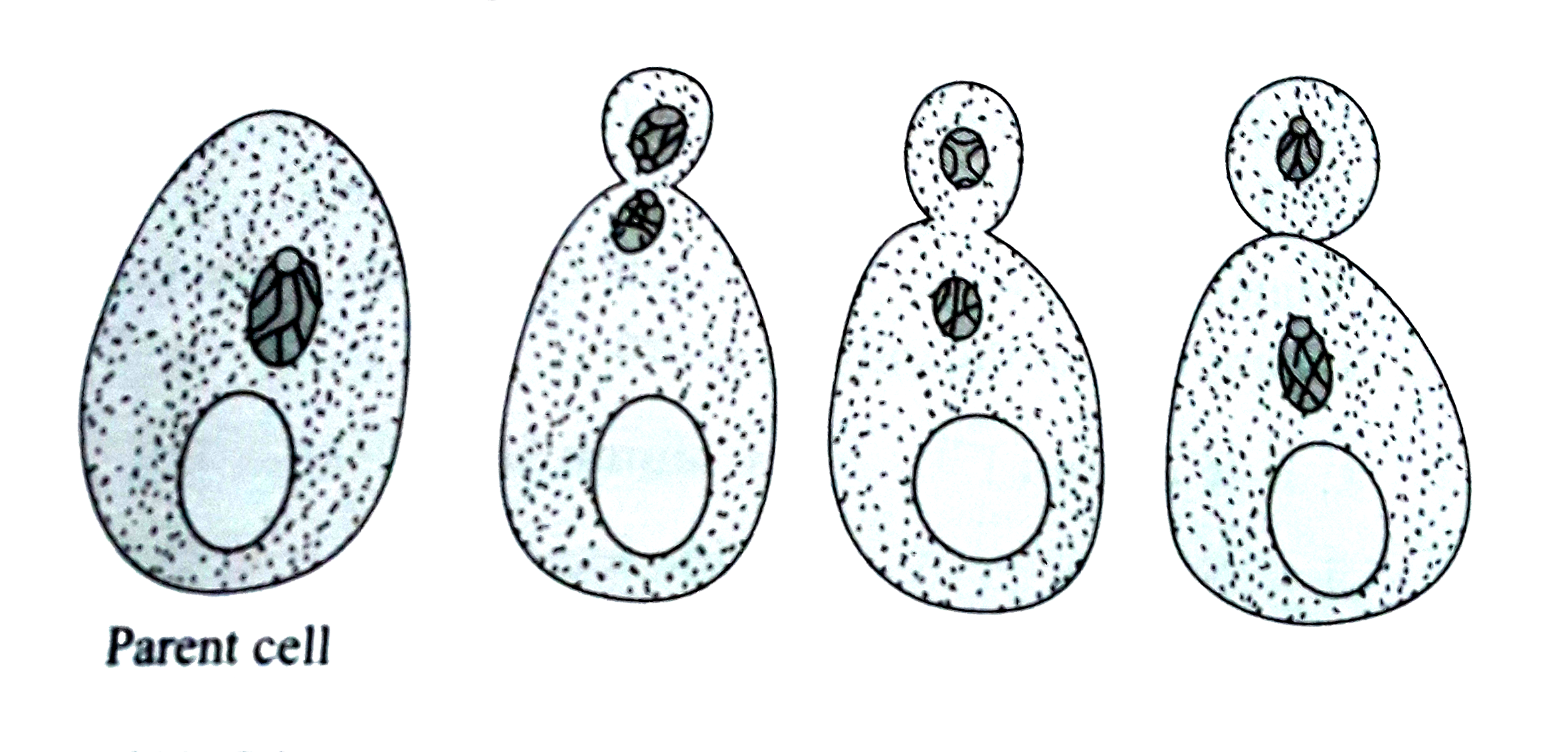
(A) Binary fission in Amoeba
(B) Budding in Hydra
(C) Equal budding in yeast
(D) Unequal budding in yeast
Option D is correct.
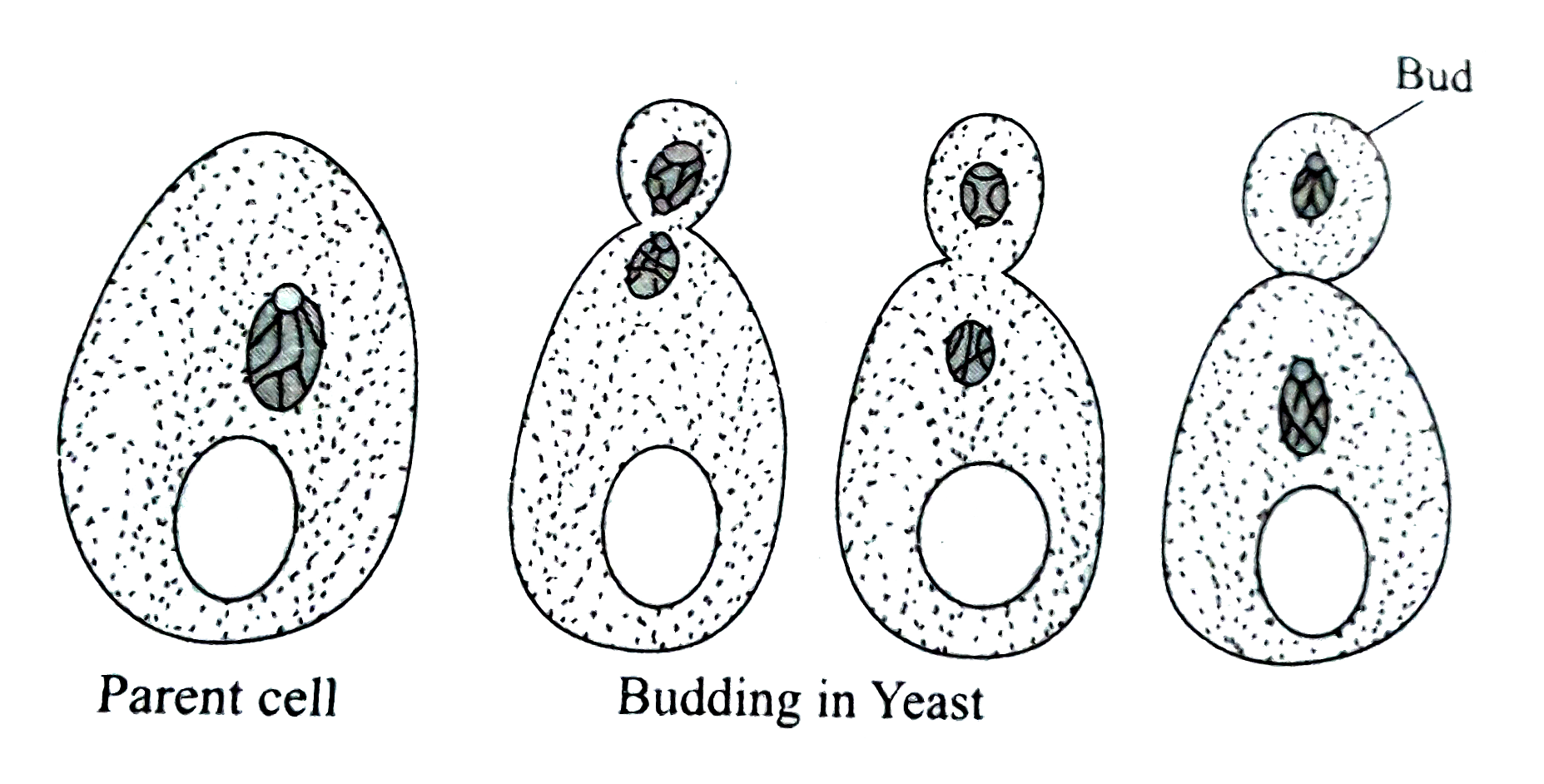
LEVEL 3
EXAMPLE 10
The following figure shows the

(A) Binary fission in Amoeba
(B) Budding in Hydra
(C) Equal budding in yeast
(D) Unequal budding in yeast
Option A is correct.

EXAMPLE 11
The end of juvenile/vegetative phase marks the beginning of the
(A) Reproductive phase
(B) Senescent phase
(C) Flowering period
(D) Maturation phase.
Option A is correct.
The end of juvenile/vegetative phase marks the beginning of the reproductive phase.
EXAMPLE 12
Many mammals, especially those living in natural, wild conditions exhibit reproductive cycles only during favorable seasons in their reproductive phase and are therefore called.
(A) Continuous breeders
(B) Seasonal breeders
(C) Reflex breeders
(D) Spontaneous breeders.
Option B is correct.
Many mammals, especially those living in natural wild conditions exhibit reproductive cycles only during favourable seasons in their reproductive phase and are therefore called seasonal breeders.
EXAMPLE 13
Which is mode of reproduction in Amoeba
(A) Binary fission oniy
(B) Binary fission and multiple fission
(C) Binary fission and conjugation
(D) Multiple fission only.
Option B is correct.
Binary fission may be longitudinal or transverse. During multiple fission the parental body divides into many daughter organisms..
EXAMPLE 14
Every sexually reproducing organism, including human beings, begin life as a single cell called.
(A) Gamete formation
(B) spore
(C) embryo
(D) zygote
Option D is correct.
Every sexually reproducing organism, including human beings being life as a single cell called zygote.
EXAMPLE 15
Fertilization is internal in
(A) toad
(B) Frogs
(C) cat fish
(D) dog fish
Option C is correct.
Internal fertilisation is the fusion of an egg and sperm cell inside the female body during sexual reproduction. Internal fertilisation, as opposed to external fertilisation, gives the female more control over reproduction..
EXAMPLE 16
Apomixis in plant means development of a plant
(A) From root cuttings
(B) Without fusion of gametes
(C) From fusion of gametes
(D) From cuttings of stem
Option B is correct.
The methods of reproduction which do not involve meiosis and fertilization are known as apomixis or asexual reproduction
EXAMPLE 17
Which is the most logical sequence with reference to the life cycle of angiosperm
(A) Cleavage-Fertilization - Differentiation -Fruit formation
(B) Pollination - Fertilization- Seed formation- Germination
(C) Germination - Double fertilization - Endosperm formation - Seed dispersal
(D) Maturation - Mitosis - Differentiation - Fertilization
Option B is correct.
A natural sequence of developmental stages in the life cycle of an angiosperm is : Pollination → Fertilization → Seed formation → Germination.
EXAMPLE 18
The stamens represent
(A) microsporangia
(B) male gametophyte
(C) male gametes
(D) microsporophylls
Option D is correct.
The male reproductive organ of a flower is the stamen. The stamen is made up of a long, slender stalk, the filament, and a two-lobed anther at the apex in all but a few extant angiosperms. The anther is made up of four microsporangia, which are sac-like structures that produce pollen for pollination..
EXAMPLE 19
Assertion : Seeds generate new genetic combinations leading to variations.
Reason : Seeds are the product of sexual reproduction.
(A) Both assertion and reason are true and the reason is the correct explanation of the assertion.
(B) Both assertion and reason are true but reason is not the correct explanation of the assertion.
(C) Assertion is true but reason is false
(D) Both assertion and reason are false.
Option A is correct.
Being products of sexual reproduction, seeds generate new genetic combinations leading to variations.
EXAMPLE 20
Which of the following is a post-fertilisation event in flowering plants ?
(A) Transfer of pollen grains
(B) Embryo development.
(C) Formation of flower
(D) Formation of pollen grains
Option B is correct.
Events in sexual reproduction after the formation of zygote are called post-fertilisation events.Development of embryo after zygote formation is a post fertilization event.
EXAMPLE 21
Multiple fission occurs in Amoeba under
(A) Favorable conditions
(B) Unfavorable conditions
(C) Both (a) and (b)
(D) None of these
Option B is correct.
The multiple fission is here called sporulation and the encysted products are termed spores. The spores remain inactive during unfavorable conditions such as desiccation and extreme of temperature
EXAMPLE 22
Each and every organism can live only for a certain period of time. The period from birth to the natural death of an organism represents its life span.
(A) Asexual reproduction
(B) Sexual reproduction
(C) Development.
(D) Life span
Option D is correct.
Each and every organism can live only for a certain period of time. The period from birth to the natural death of an organism represents its life span.
